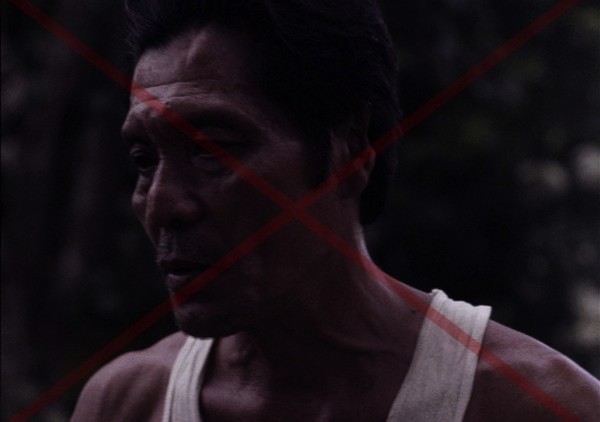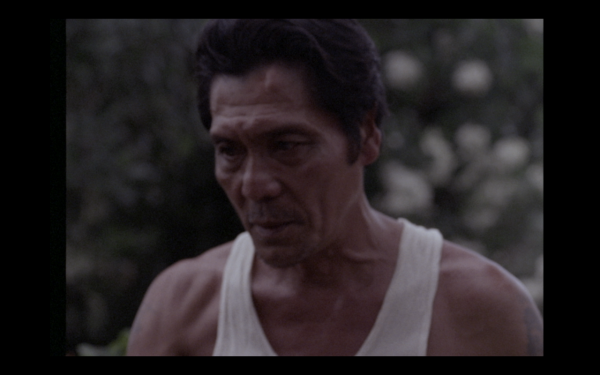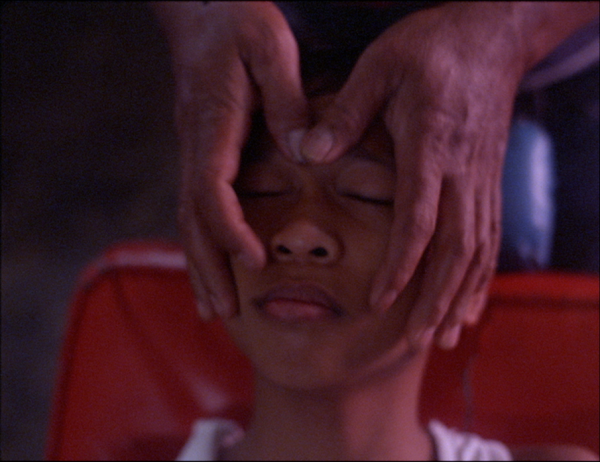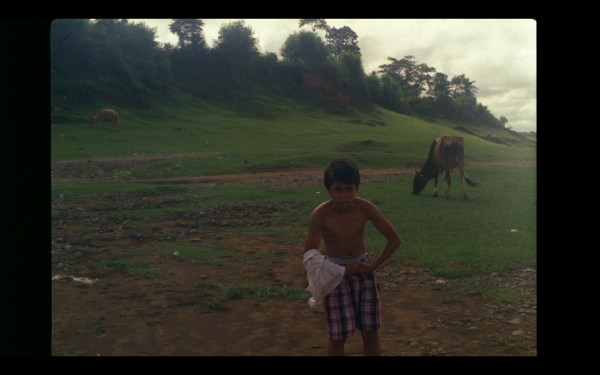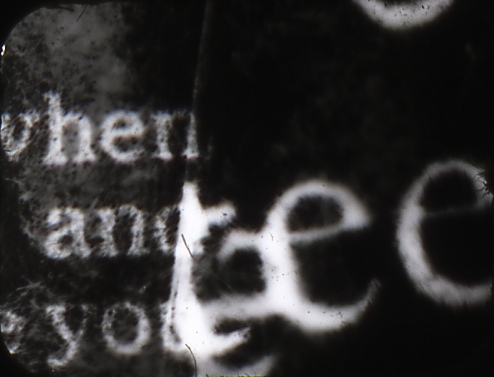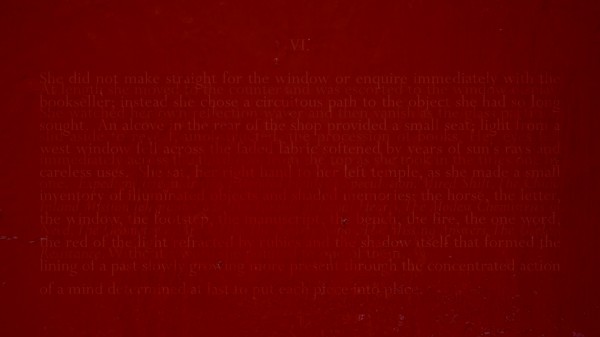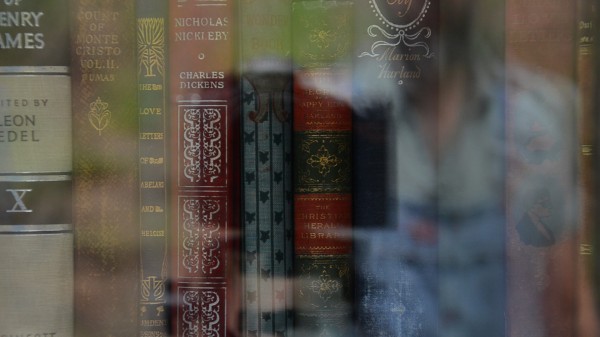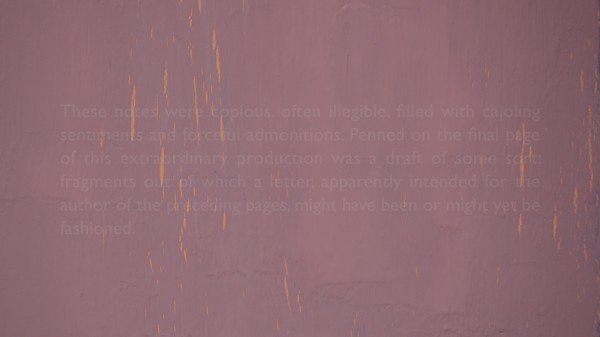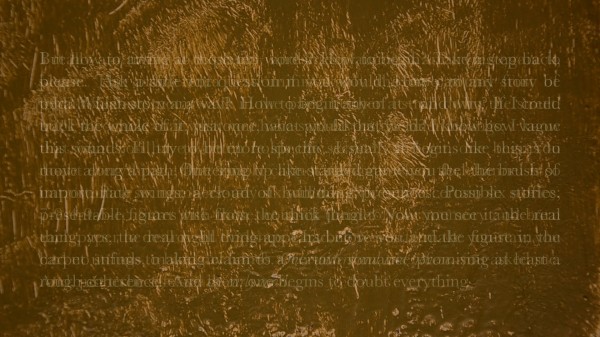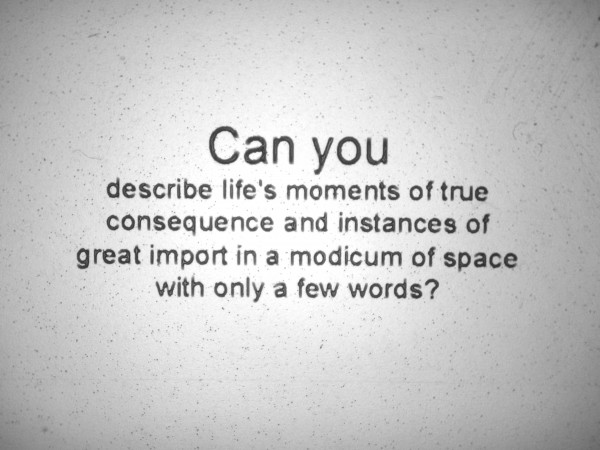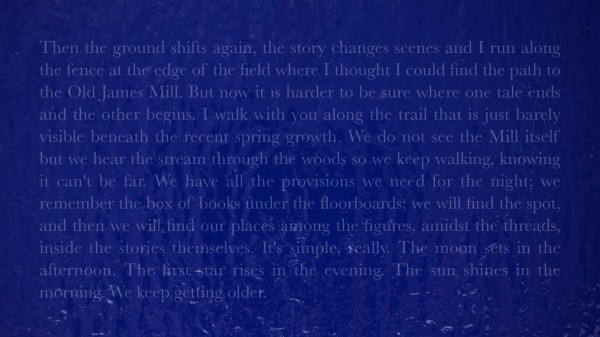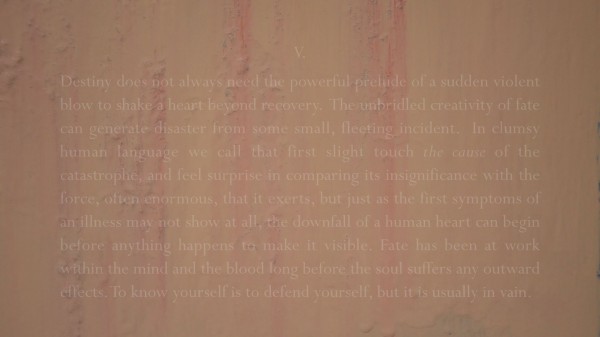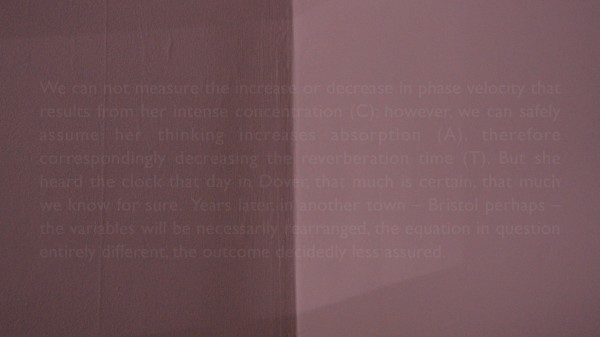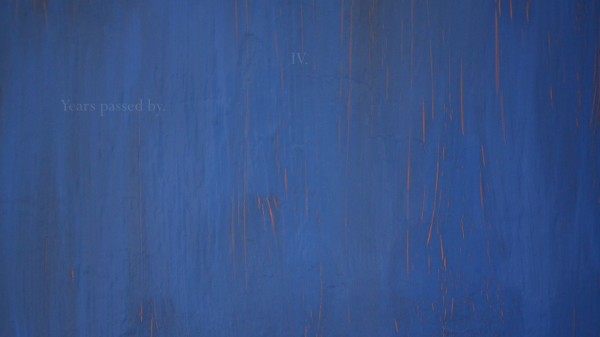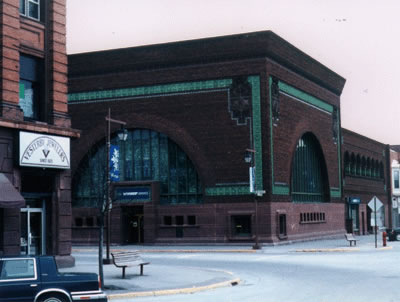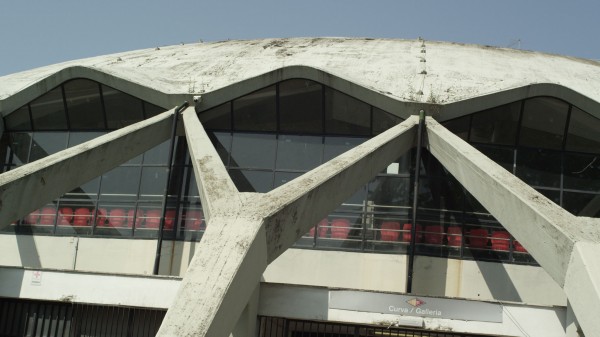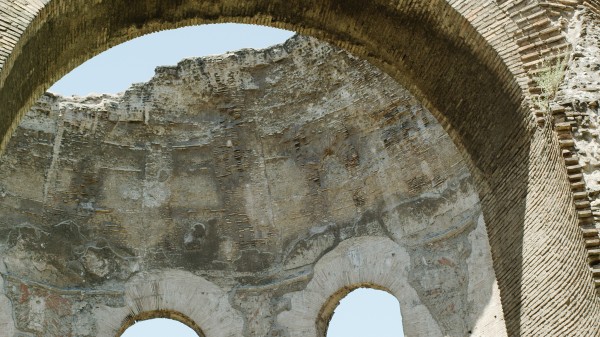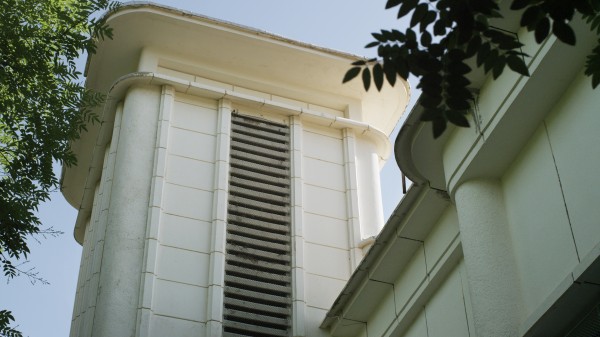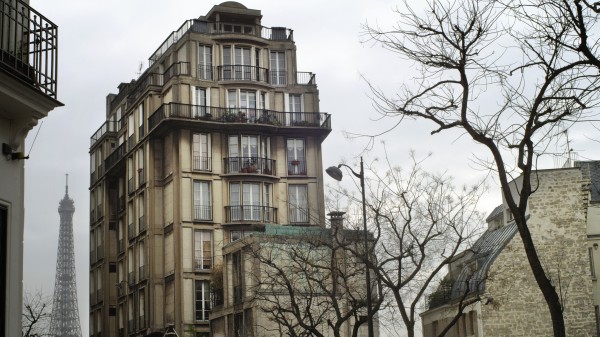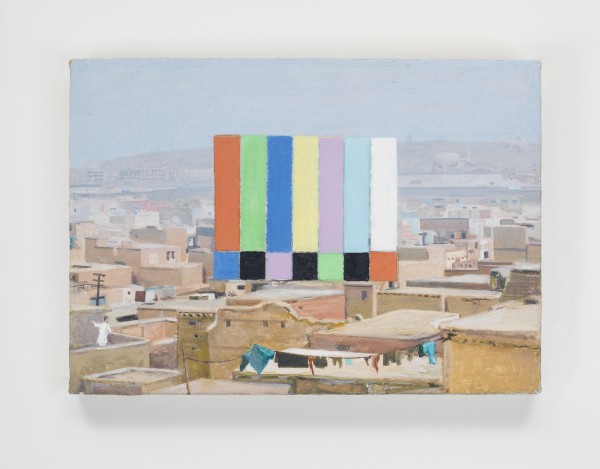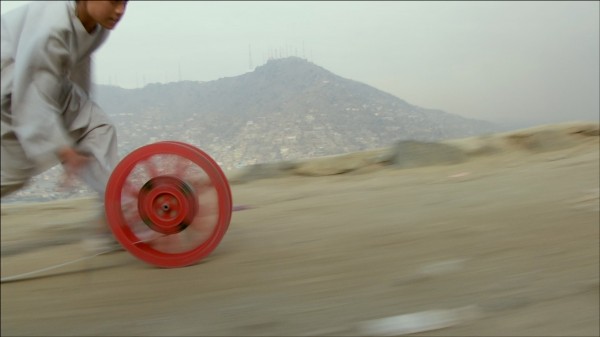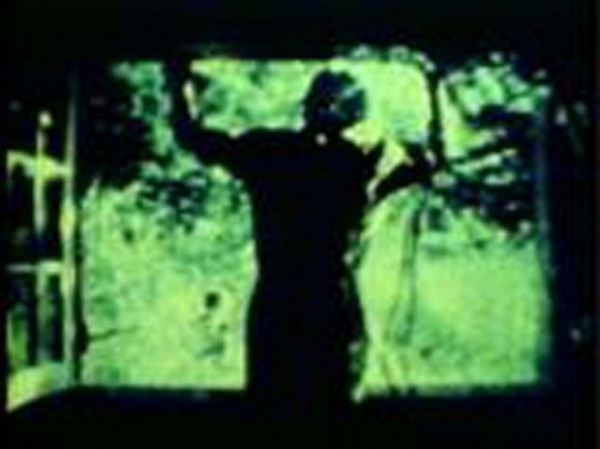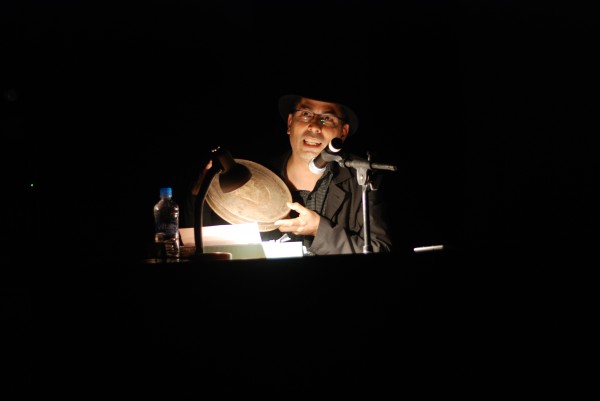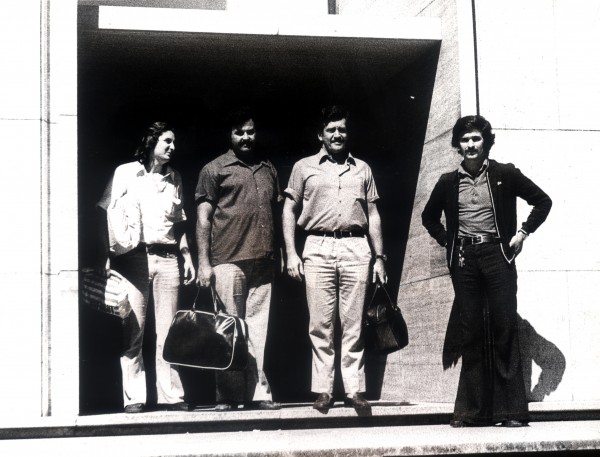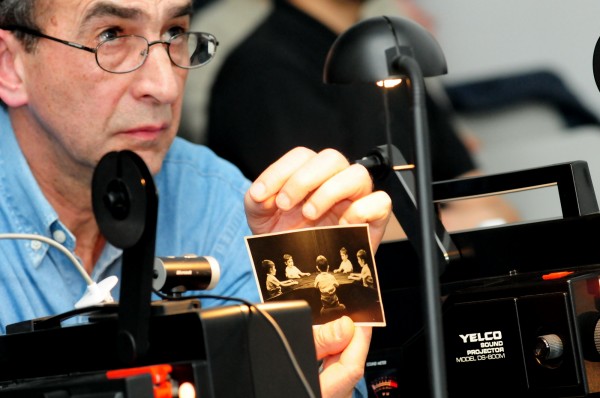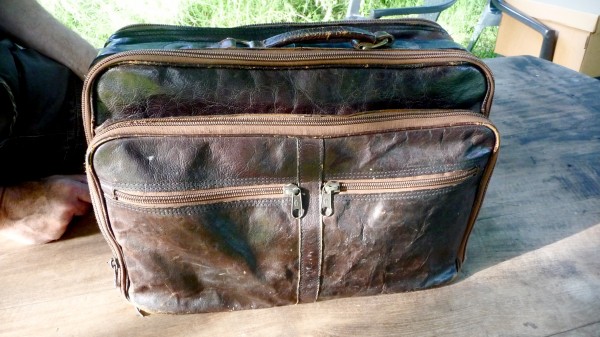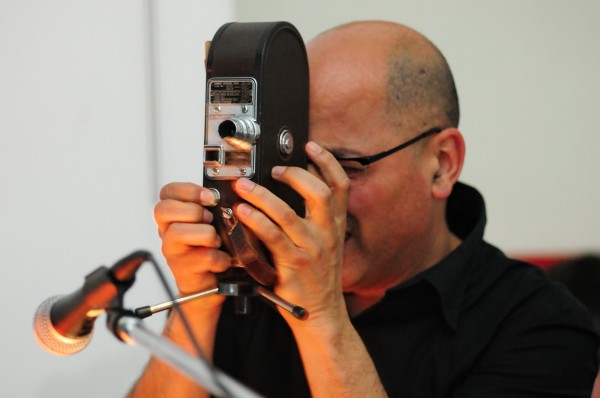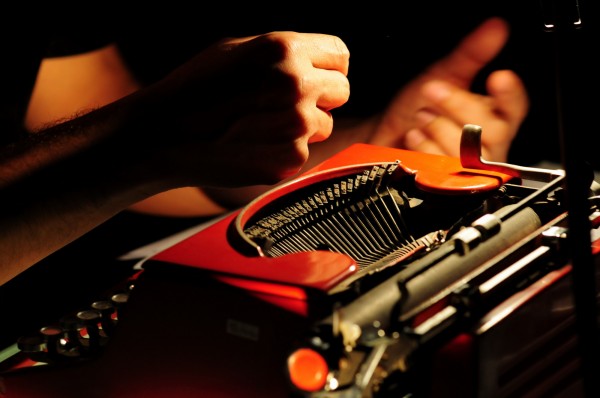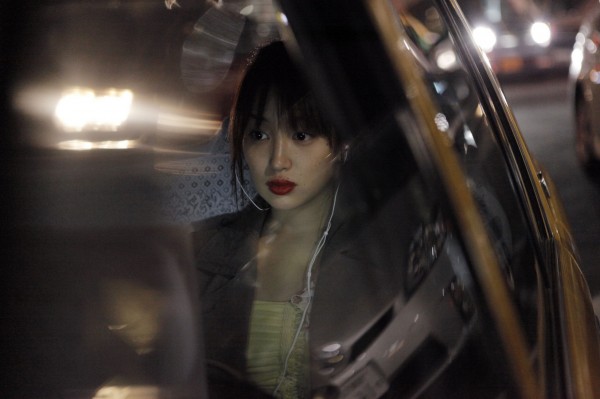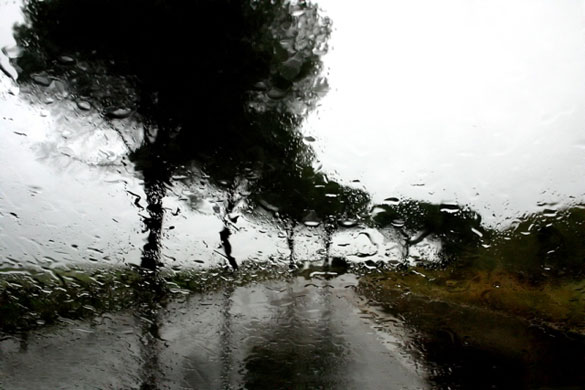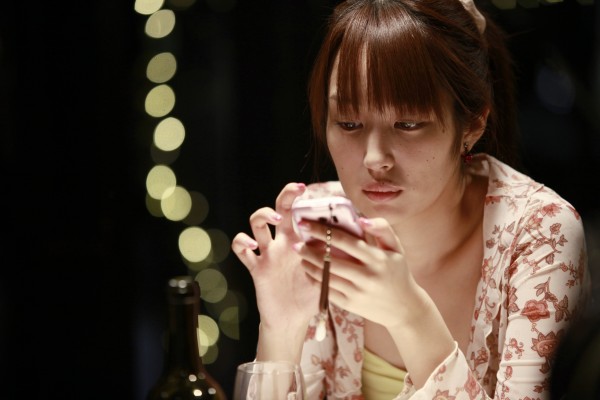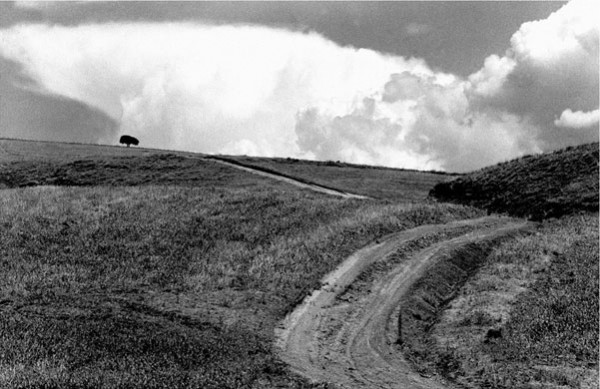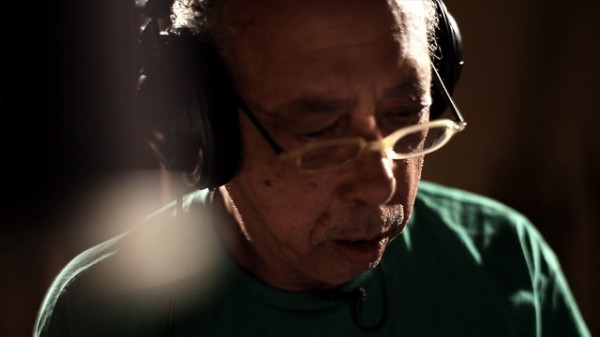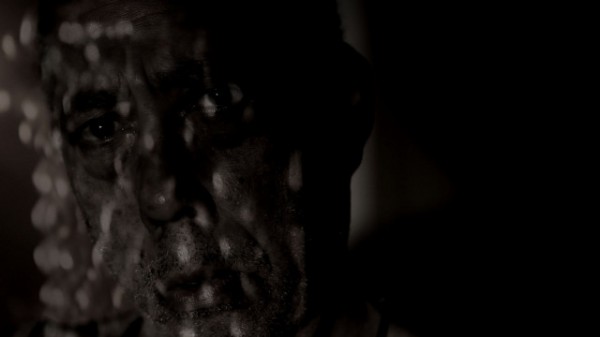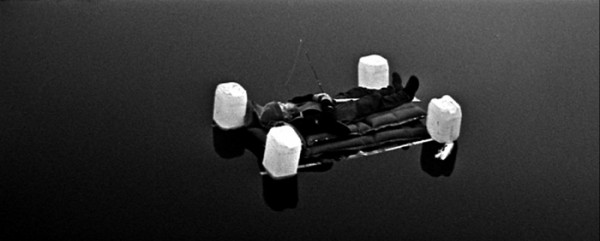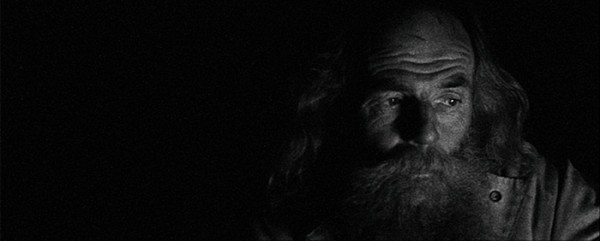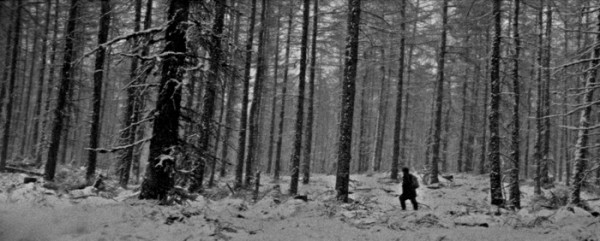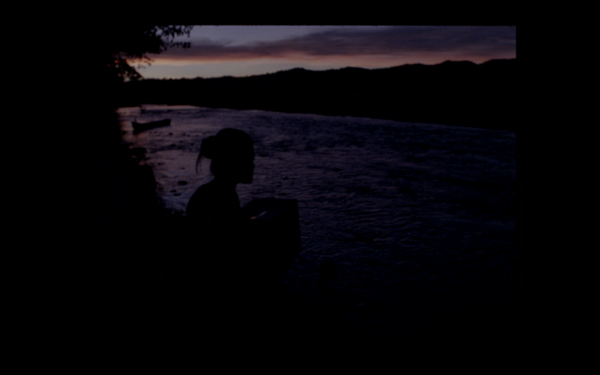
“Lukas, in the middle of the film, the actress will pay a visit. You’ll fall in love with her. And you’ll understand your father. I’ll become your memory. I haven’t shown you the middle yet.”
The words are spoken by a female voice over a black screen at the start of Lukas the Strange (2013). They make a promise while longing for a connection. It’s unclear who both this woman and Lukas are, though she leaves the sense that whatever distance exists between them will be difficult to breach. As the film continues, the voice promises to tell more about what happened—why a man left his family, why a woman grew so sad, and what was in the box that she threw into the “river of forgetting” that encircles the village. “These are things that need telling,” she says out loud, and then wonders, “But how can I tell Lukas without him forgetting?”
In all of the Filipino filmmaker John Torres’ films, stories exist to fill a void that lost memories have left, and throughout them all, the fear lingers that the void will remain. For the rural community in which his fourth feature film unfolds, a void exists in the form of an actress who’s disappeared from the film shoot underway there; for Lukas, a void also exists in the form of his father, who tells the 13 year-old, “Son, I am a tikbalang” before abandoning him. A tikbalang is a creature from Filipino folklore—half-man, half-horse. Lukas goes on to wonder whether he himself will grow up to be one then, as he dons a helmet to play a tikbalang in his town’s film shoot and casts himself in the image of a departed loved one.
Torres (who was born in Manila in 1975) had previously recalled lost loved ones in his second feature, Years When I Was a Child Outside (2008), which recreated his experience of having been separated from his father when he was young. Actors present a version of his family history, with Torres himself narrating from offscreen to “You,” creating the impression of a man reaching out to his younger self. This differed from how Torres had told his own story in the first-person in three early shorts that the critic Alexis Tioseco collectively labeled the “Love Films,” which circled around a longtime love relationship’s end. Yet even though their modes of address differed, the films shared the same impulse: to ease pain through storytelling.
Lukas the Strange, which received its world premiere at this year’s International Film Festival Rotterdam, also does this. Lukas is not just the first film work by an artist who has previously shot exclusively in video, but an overtly retrograde film in its recollection of earlier tales. Early on, brief deteriorated images appear of a young woman walking past villagers, including a young boy. These images, taken from the director Ishmael Bernal’s 1974 film My Husband, Your Lover, offer a prelude to a new work made with the grainy, occasionally flaring visuals and dubbed sound of Filipino films from the 1970s and 1980s. In drawing on this period, Lukas the Strange also invokes the years of the Philippines’ military dictatorship, during which a number of political dissidents were murdered before the military gave way in 1986 to corrupt, neocolonial democracy. As Lukas reenacts the role of his father, the present calls upon memory to help it fight absence and silence; at the same time, the film suggests the pain of remembering to be so great that some forgetting is needed. Like Torres’s other films, Lukas the Strange looks for the middle.
Tell me about Lukas the Strange, or Lukas Nino, as the film is titled in Tagalog. Is the English-language title a direct translation?
The title was supposed to be Lukas Niño [“Lukas Child”]. I was so lazy not to type in the “ñ,” so it became “Lukas Nino.” And “nino” in Tagalog means “whose.” So whose Lukas is this? Does he belong to creatures or to men?
Tell me about how you came up with it.
Man, that’s a hard question. Why do you ask me this?
Well, where did the film come from?
OK. Prepare. I’m going to try to make it really short. I have this film hero, the Filipino director Ishmael Bernal, who’s a contemporary of the better-known Lino Brocka. When festivals think Filipino cinema in the 1980s and 1990s, it’s Lino Brocka, but there’s this equally wonderful filmmaker, Ishmael Bernal, who made his most famous works around the same time. Bernal’s films have a subdued quality to them, a little dream-like, with many things that are unsaid but that you can feel nonetheless, things that are there if you look for them. He has a filmography of 40 films. Around the 15th or 16th title, there’s a lost film. It’s called Scotch on the Rocks to Remember, Black Coffee to Forget (1974). No one saw it, and I thought, “Fuck. The man’s dead, and no one’s even really looking for it.” I didn’t really care what it was. I was just concerned with a space that was left.
I initially wanted—Oh my God, this is going to be a long story. I initially wanted to write a story based on Bernal’s film titles. The sequence of film titles as you read through the filmography chronologically, such that every scene would correspond to a film title, either as a spoken line of dialogue or just looking to the poster of a film for the blocking of a scene. Eventually, though, as time went by, the finances that I had (this film was only supported by the Hubert Bals Fund) weren’t enough to have something very ambitious. I limited myself for the film before the lost film, which is called My Husband, Your Lover (1974). I took inspiration from its milieu and from its major characters and wrote a story. I took out one of the film’s major characters, an aspiring actress. A bit player, a boy seated in one of the scenes as this girl passes him, is Lukas. He is called that because Lukas is my favorite name.
So OK. This is where the milieu and the characters come from. Where another part of the film comes from is one night when I was drinking with a buddy of mine, who’s a poet. He was story-telling the whole night, beginning with, “John, my father, when I was young, told me he was a tikbalang.” A tikbalang is a figure from our folklore. He’s a half-horse, half-man, sort of like a centaur, and a prankster who makes other people lose their way so that they disappear. That’s key—they disappear. I was in a certain mood, and as my buddy was telling me all these stories from his childhood, I began thinking that he was like his father. And how could this possibly be?
At the end of the night we were tipsy. I asked him, “How can you think you are a tikbalang? How did your father tell you this?” And he corrected me: I had misheard one word, which changed everything. He wasn’t a tikbalang—he got tricked by a tikbalang. But by that point I didn’t care. Even in my previous works, I wasn’t fascinated with accuracy or with what really happened. I shot the film before Lukas Nino, Refrains Happen Like Revolutions in a Song (2010), in a land whose language I didn’t bother learning. I didn’t translate the peoples’ dialogue, I just imagined what they were saying and fictionalized everything. I even bastardized all the proper names that referred to their history on the island. I didn’t care. It was my story.
So OK. Cool. There is a third, very important place where Lukas Nino comes from, which is my own experience of watching Filipino films in the 1980s. I was consumed by all these cheesy genre cowboy Western Filipino romantic comedy action films. So consumed, but I also felt a deep self-hatred for liking them. It was an embarrassment. We weren’t supposed to feel proud that we liked this local product, and we are not even supposed to today, especially considering that you have this choice between this crappily-made Filipino film—no color grading, badly dubbed sound, music completely over the top—and slick Hollywood. But the uneven color and unsynched sound were important for me. I wanted to retain them, because they freed me. I’m not so concerned with plot or with story, what I want is feeling. There’s not much of a narrative in my film, I think. But I didn’t care. I just wanted to retain the feeling as a filmmaker wondering, “What if I shot like they did on film?” It’s this older aesthetic that I wanted to capture, even down to little things. For instance, in my film there are no fade-outs, just as there are no fade-outs in old Filipino films—shots start to fade, and then abruptly cut.
All this has to do with my experience of being a moviegoer in the 1980s, though other memories related to cinema have impacted the film as well. Aside from going to the movies when I was young, I got to experience waking up one day and seeing a famous film star on the first floor of our house. People were shooting a film, and she was crying, but only because there was a camera in front of her. Once she crossed the camera, there was a switch, and she wasn’t crying, she was smiling. She played to the crowd. I went out of the house, into the garage, and kicked at just one piece of paper, so that it fell out of position. A crew member told me not to do that again and put the paper back wherever it should have been. It was continuity, and I didn’t know, and I didn’t care, but everything in the house had been transformed. We had been transformed. All the bit players became different creatures and forgot their histories.
What interested you about the people in your film?
The place where we shot the film was my mother’s hometown. I spent summers there during my childhood, but I had not been back between then and making the film. When I returned I just knew that I wanted to talk to my relatives again and see how they had aged. I wanted to catch up on old stories. But I also wanted to be there and try to recreate in my mind how it was to be back in the province, which is around 12 hours north of Manila by bus. While I was curious about the place, I also felt so at home staying there.
Almost all the extras in the film are family members. Before shots, I would tell them the context for the scene—this is supposed to be a film shoot, and we’re shooting this film shoot, so just act normal. It was meant to be like we were casting. And we Filipinos are very, very close to this experience because with our soap operas and our films it’s normal to just have people being asked to play bit roles. They’re at home with this, so the asking is almost never a problem, and in this case there was no difficulty, either. We didn’t have formal discussions about what the film would be, nor about whether they would be paid for their work. They were just glad to be part of it, and wanted to have DVDs to watch when it was done.
The boy who plays Lukas is a nephew of mine who I never really got to know until making the film. Part of the reason for making it was that I was very interested in shooting him, and the film served as a good excuse. I discovered the actor who plays his father through a sort of chance encounter. After shooting for a few days, we realized that we had left something in Manila, so we had to go to the bus terminal to return. It was around 4 A.M., we hadn’t relaxed, we hadn’t slept, and then we suddenly saw this Elvis creature of a man who so rock-and-roll in his movements as he charmed all the women in a small eatery. I knew he was it—I had been looking for someone who resembled a tikbalang. And as it turned out, he was a distant relative of mine.
Tell me about the river of forgetting.
OK. OK OK. I have always vowed to make something simple and easily followable, but always, always, always the films are situated in my history, in our country, and in our past, and these things are not so easy to follow. The river, I think, for me, is a reference to the Marcos dictatorship that ended in the late 1980s. Because I grew up in a household that was largely Marcos loyalist, my picture of Manila was much cleaner than the city actually was. News of bodies disappearing, enemies of the administration salvaged and later found on the wayside, under thick bushes, or thrown in water, were rampant, but I still grew up believing that we needed one strong man, a dictator, to keep society in order. I then thought that we needed discipline as this “new society” moved forward along the road to progress. I was too young to experience needing to be home early because of curfews or having to join rallies. I never had anyone close in my family who was an activist, so I never really knew how it was to see loved ones disappear. But today I always hear of Marcos’s cronies and the military conspiring to take away civilians who were too outspoken against the administration, and when I was making this film, I was fascinated by how the ex-military men are living their lives now.
There’s a big representation in the film of what color people wear, red or yellow. In Filipino history, yellow stands for democracy, and red for dictatorship. (In the film the film crew wears red, and Lukas’s helmet is red and yellow.) I would always think that maybe those people who would want to forget are people like Marcos’s soldiers, who made other people disappear. I think it’s easier for them to forget. They’re wired for crossing the river. Not anyone can do it. It takes great strength and fortitude. I think that they’re the ones who really need to forget.
I was wondering about disappearing bodies. How can one person really think he is a tikbalang? Maybe there’s this cycle of disappearance in his life, and in the 1980s, salvaging people—meaning dumping them into fields so that they never get to be seen again—was done by Marcos’s police and soldiers. These military men are so much like the tikbalangs in my film. By throwing bodies into empty lots and fields, they have also made people disappear. I even imagine them looking like tikbalangs, their appearance mutating, similar to those changes in a soldier’s face coming home after his first experience of battle. Sorrow and guilt housed in a chest for years can mutate someone into a hybrid of man and beast.
So I was thinking maybe if we had the father as well as ex-military men, what if they were thrown into this island together? How would they be able to cope? They would need to invent a river so that they could forget, I thought. (Initially I didn’t know it, but I was making a reference to the River Lethe, which in Greek mythology can supposedly be its own river of forgetting—you forget things if you drink its water.)
And I also need the river. I think that part of the film is my saying that I don’t care about the wounds pain leaves behind. I think it’s much simpler to have this river instead. My past is contained there. Growing up, my father was my idol. He wrote storybooks for children and how-to books for adults, and he earned enough money for us to afford a better life than we would have had without him. I always put him on a pedestal. He was the reason I got started with video-making—he always spent so much on camera and other gear that I was able to start early and use cameras for school projects and practice editing well before college. But my father broke our hearts when I was a young man, when we learned that he had a secret life with another family that lived near us. This is explicitly the subject of my second feature, Years When I Was a Child Outside, but with Lukas the Strange, there is also much of my father in Lukas’s father.
So the river contains many things that have been lost. Lost people. Lost film. Lost instances. Lost moments. But we also find things in the river, like the tapes of this woman guiding Lukas and narrating his story.
How did you come up with the writing that appears onscreen?
First off, it’s very much ingrained with the process that I’ve set for myself, even with my short films. Inter-titles and subtitles are always onscreen. But with this project we decided that I would use inter-titles when the narrator had difficulty in admitting something to Lukas—something really serious that could change her relationship with him. There are also some things that cannot be said. She tells him, “There are some things that I can tell you, but there are some things that I can’t say.” And these things are presented as titles flashed onscreen while Lukas remains silent.
In my previous works, I have always had different starting points, although process-wise, I think that Lukas the Strange continues my desire to strip down what I have done so far and what I can do and see what else is there, so that I know what remains in my work and what changes in it. One particular difference from my previous work to this film is the use of my own voice for voiceover. Previously, I would always narrate, even in my short films. But I was really tired of hearing my voice all the time, and on this film I wanted to see how it initially was to tell a story without a narrator. Eventually, though, that didn’t seem right, either, and I felt the wrongness in my gut. I thought I was missing someone. I was missing my friend who was telling me about his father and about his true-to-life childhood. I missed this possibility of mishearing this narrator/friend, this chance to hear someone who might be making up or mixing up the story after all. I missed the confused voice of a troubled soul. And so I made a big, big creative decision to have this witness—or this friend/muse—narrate everything. This person who is everywhere, who is somehow remembering all these things—not exactly creating from scratch, or representing what really happened. She’s telling a story.
Do you believe there is love in Lukas the Strange?
There’s love. Love is my first instinct, my first impulse to do this. It’s always about this, in this film as well as in my others. And I can’t tell you in words how love is vital to them, so maybe the films are enough.
All images accompanying this interview were provided by John Torres. The interview was conducted at the 2013 edition of the International Film Festival Rotterdam, which also screened a film produced by Torres. Shireen Seno’s Big Boy tells the story of a postcolonial Filipino family stretching their first-born son’s limbs as far as possible in the name of progress.
]]>It was an October afternoon last year at the Brooklyn screening space UnionDocs, and our group of five was awaiting David Gatten. He arrived distinctly attired—small-lensed glasses, a scraggly beard, overalls, and a heavy knapsack, from which he removed prints of eight of his eighteen completed 16mm films. Some he hadn’t brought because he’d made them to be shown at an outdated projector speed; one was unavailable because his print remained in California under an old girlfriend’s care. But the films he had on hand he would project himself and discuss with us.
This is a frequent practice for Gatten, who was in New York for the world premiere of his latest work, The Extravagant Shadows, at the New York Film Festival’s Views from the Avant-Garde sidebar. We arranged our private screening because we might never see his remaining works otherwise. His films are unique art objects, rendering chances to view them rare. He explained that no more than three prints of any exist; some, like the What the Water Said series (unprocessed filmstrips exploding with sound and color, the product of Gatten leaving them floating in crab traps off the South Carolina coast), could never be reproduced. Each time a film of his runs through a projector, he said, it dies a little.
These delicate, fragile works need care and attention to survive, much like a key Gatten subject: love. And like much of the output of his self-professed model, Hollis Frampton (whose ode to his own maternal grandmother, Gloria! [1979], is Gatten’s favorite film), they devote themselves to building systematic frames within which love can be articulated. The frames are often made from forms of written language, whether densely coded Western Union messages (Film for Invisible Ink, case no. 323: ONCE UPON A TIME IN THE WEST [2010], prepared for his wedding to fellow filmmaker Erin Espelie) or phrases plucked out of direct, despairing summons written to a beloved from across an ocean (The Great Art of Knowing [2004]). His most celebrated project has been an ongoing nine-part film series, begun in the late 1990s, called The Secret History of the Dividing Line, with each entry named after a book belonging to 18th-century Richmond, Virginia founder William Byrd II, whose library contained over 4,000 volumes. The series’ four completed films, all silent (though Gatten prefers to call them quiet) and three of the four in black-and-white, tremble with close-ups of thick, richly engraved words soon to disappear from sight.
It takes words much longer to vanish in The Extravagant Shadows, Gatten’s first digital work, which will be screening again in New York (in a session curated by Views programmer Mark McElhatten) at Lincoln Center on Monday, April 29 at 7 P.M. with Gatten in person. They fade in, ghostlike, forming cryptic messages over layers of paint with which the artist has covered a bookcase’s glass front, then haunt the screen for several minutes as they fade back out. Though many originally come from other writers, including Stefan Zweig, Maurice Blanchot, and Henry James (from whose short story “The Jolly Corner” Gatten took Shadows’ title), the tale that they obliquely tell—made up of overlapping possible stories that lovers might share, if chance allows—is of Gatten’s invention.
How did you learn to read?
I cannot completely remember learning to read, but I know that books were always a tremendously important part of the household. We did not listen to a lot of music. Music was not on all the time, and was a very special event when it was played. Books formed the architecture of our home. My mother majored in Shakespeare at William & Mary. My father would read to us for an hour every night and my mother would read on the weekends. My earliest memories of literature are of having it read aloud to me. I am certain that Dr. Seuss was an important beginning, and I feel like I learned to read and took pleasure in reading early on. My parents would take us to the library every week, where we were allowed only three books. That wasn’t a library policy, but a family policy, which put into place an idea of scarcity, and a need to then choose carefully. Books were serious and special things. So I spent all of my allowance money on buying them.
My relationship to the written word became problematic when I tried to learn to write cursive, because in the 1970s in North Carolina public schools, if you were left-handed you were still referred to as “the Devil’s child.” As a left-handed person I was too much for the teacher, and was put in the corner with crayons to draw while everyone else learned to write. I have never had an easy relationship with my own handwriting, and in fact, much of the time I cannot read anything that I write. I believe that this problem has become a fundamentally important condition for my thinking about text as image in cinema, and issues of legibility and illegibility. Hardwood Process (1996) is largely a movie about my inability to read my own diary. The film has 14 sections, each beginning with a phrase. It’s all stuff that I couldn’t read, but that I knew was important. So I had to make images to complete the phrases. Even today, at age 41, I am still frequently unable to read something I have written by hand. I am still learning how to read on a daily basis.
How?
I’ve learned to read very differently based on the kind of books I have been reading. David Markson is one of the two “skeleton key” writers that have inspired and informed my cinema—the other being Susan Howe, especially her book The Non-Conformist’s Memorial (1993), and within it the poem “Melville’s Marginalia.” Although my method of writing and condensing writing was pretty well developed by the time I read Markson’s This Is Not a Novel in 2001, I feel I was deeply altered by it—and then also by a subsequent reading of Vanishing Point (2004). I found it both one of the funniest and one of the most emotionally devastating reading experiences of my life. I think there could never have been the Films for Invisible Ink [a series of films specifically made for friends and loved ones]—especially the first one, Film for Invisible Ink, case no. 71: BASE-PLUS-FOG (2006) [made for Gatten’s first wife, Weena Perry]—without it. And I’ve been going to school with Markson ever since. Those last five novels of his speak so strongly and directly to a poetic and narrative strategy that I find moving as a reader and, at this point one happily and nearly inevitability at play in my own work as a filmmaker. Touchstone works by a writer of enormous humanity.
I also learned how to read over the last seven years from reading Henry James.
How did James inform The Extravagant Shadows?
“The Birthplace,” the short tale in which the young couple is caretaking Shakespeare’s cottage, is the first James text that appears. It initiates a narrative about a young couple going to live in a place that is inhabited by a spirit they can’t see, but with whom they want to commune. I used this tale as the launching pad. It immediately seemed related to, but different from, the James tale, “The Jolly Corner,” which is about a man who is going back to a house that he owns but hasn’t been to for years, and who, as he starts to visit it, also starts to recognize the life he might have led. “The Jolly Corner” is, in my reading, very much about a consideration of another self. Those two stories I had read many years before and confused. They had been condensing for years in my brain before I came back to try and capture something of them on paper.
So there were situations and a narrative thematic that James provided immediately. But much more important was the way in which he deploys language to describe a series of events, which might be actions in the external world or the internal clockworks of emotions and of decision-making processes. The way he will circle around something, with the most important things being what he leaves unsaid. He makes beautiful outlines with language. I was interested in the specific instances of language he uses to do that, but also in his greater approach to storytelling. All of the storytelling in The Extravagant Shadows is based in a late Jamesian mode of proceeding through an event, an idea, a character, or an emotion.
James is there in almost every panel of text. I wrote most of the text myself, but I was writing in relation to James almost the entire time. James makes visible the process of thought, which of course happens very fast, but through his use of language, he slows it down so that we are able to understand someone else’s thinking. A character’s, but also his own, with all the hesitations and circling back in slow motion, which allows for analytic examination. With The Extravagant Shadows I’m trying to do that. I don’t think it’s a slow film, but it is a place to reside in for a long time. I hope that there is a lot of time to consider small details, whether those are details of language, of paint, or of light shifting.
How did The Extravagant Shadows form?
I have always worked slowly, but the older I get the slower I am working, and the longer I am willing to work on a project. The Extravagant Shadows began in 1998 with an idea about certain pieces of language, based in Blanchot. I knew I wanted to make a work where language was staging itself very, very slowly, much more slowly than I could accomplish with what I knew about filmmaking at the time. I was in graduate school at the School of the Art Institute of Chicago, and was doing a lot of contact printing and optical printing. On a contact printer the longest fade you can have is 96 frames, or four seconds. On a small JK optical printer it’s very difficult to make something longer than four seconds, and I knew I wanted fades to last minutes, and for things to hover on the edge of legibility for minutes. I knew that I wanted to work with an analogue video image and text generating, so that I could have a different kind of control over time. I assumed that this work was going to be an analogue tape. There was very little text then compared to what there is now. It was going to be a much shorter piece, maybe half an hour long. But I didn’t know how to make it, and it wasn’t urgent to make at that moment, and other projects took over. This was at the same time that I was discovering the Byrd project, and that took hold strong. So The Extravagant Shadows, which wasn’t even called that then (I think it was called Area Effect), just sat.
I came back to it a few years later and fiddled with the text some more. A lot of what I do in the studio is sit and write. I’m not always working with strips of film. I’m not always in the darkroom. It is often reading and writing. The studio is a place to consider words, and to structure my own words, as well as to produce images. So I would write. Sometimes if I got stuck on another project I would return, but I mainly kept putting it aside, and putting it aside. I’d shot some stuff on VHS that didn’t have anything to do with the images that we’re looking at now. I was actually shooting a TV monitor of a snowstorm on bad antennae reception. There was the snow of the storm that the weather channel was covering and there was the snow on the screen itself, and that was serving as a background for these words to emerge from. And I thought that that was interesting, but I wasn’t wild about it. I knew at a certain point that I was going to work with a mini-DV camera, but that didn’t end up going anywhere either.
Then I moved to New York in 2006, finished the first Invisible Ink film, BASE-PLUS-FOG, and went back to what, at that point, I knew to be The Extravagant Shadows. I was reading Henry James on a daily basis, and conversing with a friend who was also reading James. We would wake up every morning, call each other, and ask, “What’d you read last night? How was it?” For two years we were reading James almost every day. Mostly not the novels—mostly it was the tales. We systematically made our way through nearly all 112 tales, and talked about them, and that is when the piece started to find the shape that it has now. I knew it was going to have a Jamesian structure, that the characters, the situations, the ambiguities, the events would have something to do with the way James represented the world through language. And that there would be phrases, but that I was going to write through them, around them, and to connect things from a dozen of the different tales to make a new story that doesn’t exist in any James tale, that doesn’t exist in any Blanchot book, but that borrowed from and condensed them.
I use the term “condensation” in relation to texts. I am trying to build cinematic structures that replicate the process of condensation within a glass of water, allowing for things that are in the air to be fixed, find new form, and group together as visible, light-catching substances. What I’m trying to pull out of the air is language. These cultural productions that exist as books, I’m trying to build a cinematic structure to condense them. It’s an active reading process, first of all. It’s recognizing that this phrase connects to this phrase, and that if there’s this idea here, and there’s another idea 18 inches away, I’ve got to then use language to make the connection to draw these two things together. I believe that poetry often operates as a kind of condensation which functions through ellipsis, an economy of means, and a high level of organization. Shape is important in poetry. It’s deeply important in prose as well, but there it’s articulated in a different way, and often at a different length. I am trying to boil down experience and language into a smaller vessel. I am still working out this poetics, and am just starting to understand it as a tool, rather than something that I recognize that I do. I didn’t say, when I started doing this, “Now I will condense this text.” I just found myself doing it, and it was during the last couple of years of writing The Extravagant Shadows that I came to understand it as an approach that I can apply to any existing text to make a set of new meanings. To take, as I do, a Wallace Stevens poem, “Description Without Place,” and condense it into 24 lines by taking certain ideas, leapfrogging over others, and forming a new poem. With Stevens, with James, with Blanchot.
That writing process took up a lot of time. But it was only once I started teaching at Duke University in 2010, and once Erin and I moved to the cottage we live in when we are at Duke, that things really coalesced. I started shooting the cottage walls because I love the colors the walls are painted, which were the existing colors when we moved in. Home is really Salinas, Colorado, all of our things are in the cabin there, and the Durham cottage is quite minimal by comparison. We don’t put things on the cottage walls. The walls are painted, and the paint is beautiful. I felt that the walls were speaking.
In 2011, I started filming—not filming, but shooting with Erin’s Nikon D-7000. I started making images and recording sound in the cottage. I was so inspired by the paint that I wanted to start painting myself, mix paints, and experiment with layering colors and producing effects of color and light rendered digitally. All of the painting that we see in the final form of The Extravagant Shadows was performed in May, June, and July of 2012 in Colorado outside the cabin. It was very important to do the painting outside, where the clouds could move across the sun and change the color temperature and affect that world of paint. I didn’t want it to be a static, studio-lit situation. I wanted low relative humidity to help the paint dry, and I wanted the paint to be alive to the changing of light.
So it was a circuitous path, with a lot of stop-and-start. And then, as there often is, there came a moment when I could think about nothing else. I was intending to finish the new Byrd film, but The Extravagant Shadows said, “No.” I was so surprised. I’ve been making work for a while, and I know what I’m doing as a 16mm filmmaker. I’m deeply surprised about what happened with digital cinema and The Extravagant Shadows.
What is your background in painting?
It stretches all the way back to May of 2012. I had never painted anything before then, except for places where I had lived, where I was just painting the walls. I wasn’t painting pictures, I was applying paint, which I like to do, but I had never painted before. I like to look at paintings a lot, though. Adriaen Coorte’s painting White Asparagus at the Rijksmuseum in Amsterdam—in which the white paint has faded to the point at which the image of the asparagus is really a translucent ghost of itself—is probably my favorite painting. And then I often think most of my filmmaking operates in relation to experiences I’ve had with Agnes Martin’s work.
Part of what I’m interested in in cinema is exploring materials. With the What the Water Said project, I put into play the substances of the ocean, the river, and the filmstrip. I didn’t know what was going to happen—all I did was throw the celluloid into the water. With The Extravagant Shadows I chose different kinds of paints. I chose oil-based enamel paint and acrylic paint, and I layered those on top of each other and let them make the picture. I didn’t control—I just wanted to see what would happen with the relative humidity of the air, the intensity of the sunlight, and the way that those paints reacted to each other. They’re not made to be used in tandem like that. So it was about letting the materials articulate themselves.
As the movie goes on, I start to do things with the brush to provide different conditions for them to articulate themselves into different kinds of images. The paintbrush starts to activate different characteristics of the paint. It starts to layer or smudge things, or work with one layer before the other layer is completely dry. I was learning. I was listening and watching the paint as the shoot went on, and trying to respond to what I was learning. I then started making some paintings, but found that they weren’t interesting to me. What I was interested in was seeing paint dry. As soon as the paint would dry, I would apply more paint, so that it was never dry and always drying. The painting never finishes. It never stabilizes. It’s always changing.
What are the extravagant shadows?
For me, first and foremost, they are language. It’s the words themselves—and the ideas, stories and emotions they describe—that can’t be contained, erased, painted over. They are so extravagant that they cannot be effaced. I was keenly aware when making this that it was a digital work, and that as a digital work, it in some ways flew in the face of the aesthetics of the mostly black-and-white 16mm Byrd work—and most everything else I’ve made. And many of those films—The Great Art of Knowing [second film in the Byrd sequence], The Enjoyment of Reading (Lost and Found) [2001, fourth film in the Byrd sequence], the new, still-unfinished Byrd film in particular—are filled with shadows, with dappled light, with extravagant expressions of light and dark, kinetic (and I believe beautiful) expressions of light modulated through shadow. Those films are filled with extravagant shadows. My guess is that when people see this new title and think of my work, they’re thinking of visual shadows. But I wanted to get at something less literal. The early gesture of painting out the books is, I think, a notice that this isn’t going to be the same space. We’re not going to be considering the book-as-object. We’re going to be considering what the book contains, and what it might evoke, as opposed to represent. There are shadows in this digital work, and there are reflections, but they are considerably more subtle, although perhaps no less extravagant, than in the 16mm work.
Do you feel these shadows coming to life?
That’s the goal, and I hope they do. I ‘m moved that viewers thus far have seemed so committed to giving them life through their attention. That’s the only way they can come to life—through someone’s concentrated and generous imagination.
There are certain kinds of movie experiences—which I love having—where everything is largely determined. If you go to see the Lord of the Rings movies or the Jason Bourne films or a Soderbergh in a certain mode, then you are going to live inside a world that is built almost airtight and perfectly articulated. You will identify with characters, you will lose yourself, the meaning is blazing off the screen, and you are actively subsumed in it. This is one kind of experience, which commercial cinema frequently seeks to produce.
My background of consuming and enjoying that probably helped me conceive work that was different from commercial cinema, and closer to the aesthetic experience of the fine arts. I admire the idea of the oppositional cinema, but what I’m making is just in favor of itself, and not necessarily opposed to something else—I like the other thing too, it just isn’t what I’m doing. I prefer to think of cinema as an ecosystem with different kinds of works existing at various points along a continuum rather than simply being in opposition to each other. For the kind of experience I seek, I don’t want anyone to forget who they are or where they are, and I want my viewers to be active in a different way. I want the chief activity to be that of the viewer approaching the screen, and for the meaning of the work not to be inherent, but rather to be a product of someone’s engagement with it.
Now, that is not to say that anything goes.Rather, it means that my job as a filmmaker is to define a field of play containing multiple paths. This is what Umberto Eco describes in his great book, The Open Work (1962). When I encountered that book in graduate school it articulated many things that I was feeling about experimental and avant-garde cinema and that I admired, but that I couldn’t articulate for myself.
Why don’t you attribute the source texts in The Extravagant Shadows?
I have made some attempt at attribution in the printed material, but not in the work itself. I use other peoples’ texts in almost everything I make. Quite often there are attributions at the end of the films, and quite often there are not. My name appears at the end of some works and not in others. Because that is a shot, it’s not just credits. That’s the last shot of the movie. I am thinking about these things as images. I could not possibly end Secret History of the Dividing Line [2002, first film in the Byrd sequence] after the words “Here ends the Secret History” by then putting “David Gatten 2002.” That would be preposterous. That would be another image. Here would not have ended the secret history: it wouldn’t be over yet. I would never put my name at the end of The Great Art of Knowing. That would be like a desecration of what I was trying to do. Yet at the end of the next two Byrd films, I not only refer to texts, but my name is on the films. In Moxon’s Mechanick Exercises, or the Doctrine of Handy-Works Applied to the Art of Printing [1999, third film in the Byrd sequence] I cite the translations, the translators, sometimes the press itself, because that was a book about translation and the printing press, and so that is an appropriate image with which to end that film. That wasn’t an image that I wanted to end The Extravagant Shadows with. I wasn’t going to go to a black screen after those books. The last image of that film had to be book spines. So there was not an appropriate place within the image sequence to put that attribution information. It’s not secret. It’s not that I don’t want people to know. It’s just that there is not an appropriate place to relate that onscreen. It’s an aesthetic concern. Other filmmakers often use credits as bookends. For me they’re covers.
Did you see a similarity in the relationships between celluloid and digital photography and between the physical book and digital text?
I didn’t think much about digital text—in the form of electronic books or reader devices per se. I’ve seen people on the subway carrying these E-readers, but I’ve never actually held one nor tried to read from one. So I suppose it is amusing at some level that I’ve made a three-hour movie that is all digital text and is essentially an electronic reader. I really wasn’t thinking about it in those terms while making it—I was more concerned with, and interested in, the difference between working with celluloid film titles and computer-generated text. Of course we’re going through a tremendous change in print culture—we can’t even call it print culture anymore—reading culture—in the same way that we are going through a transition with the moving image. I have addressed this before. The transition from celluloid to digital I was trying to get at in 1999, when I made Moxon’s Mechanick Exercises. Joseph Moxon produced the first manual of style to tell printers how to print. I was trying to go back to the moment when we moved from scribal reproduction to mechanical reproduction of texts with Gutenberg’s invention of the printing press and the printing of the Gutenberg Bible. One can then draw the celluloid-digital analogy within The Extravagant Shadows, where at the beginning I put the books away and then bring out the text. The object disappears, but the text persists. I suppose at that level it is some sort of comment on the status of the book in the 21st century.
It is largely a quiet film, but there is some sound. How did you make your soundtrack choices?
The music—five songs from a 1968 Merrilee Rush album called Angel of the Morning—I took as the soundtrack. I was interested in using those songs as texts in the exact same way I was considering works by Henry James, Stefan Zweig, Roger Gard, and Lao Yee-Cheung. They are conveying narrative information, in a voice that has emotion and phrasing. I was thinking of the songs as another set of texts, manifesting language differently. Not just onscreen, visual language, but sung language. And all of those songs have particular emotional dynamics that intersect with some of the narrative thrust or the situations in the other texts.
That’s about the music. One of the big differences between shooting 16mm film on a Bolex and shooting digital images on a Nikon D-7000 is that the digital camera assumes sound. It automatically records synchronous sound, whereas a Bolex does not. It’s actually tortuously difficult to record synchronous sound in film. You’ve really got to make a point of it. And with a Digital SLR (DSLR) you’ve got to turn off the sound. You’ve got to go to a bit of trouble to make it a silent recording. So it felt important to acknowledge that, and to let there be a moment where the image gains dimension through the genuine synchronous sound of a particular place. I make that gesture at the moment in the movie when I want to address sound. Up to that point—one hour and 18 minutes—there has been a lot of mention of sounds and spoken language. In all sections of the narrative thus far, the text speaks about characters hearing things. So I hope that we are primed as viewers to already be thinking about what it means to hear something. I then wanted us to hear something, and then I wanted that to go away. It was important to explore something that I had never explored before, but that is inherent in working with a new digital camera.
A few days before I saw the film, you told me that Hollis Frampton’s film Gloria! would help me make better sense of it. It might have been because of the way that Frampton uses music. How do you see the usage of music in the two films as synchronous, and what other synchronicities do you see?
When I saw Gloria!, I felt Frampton was almost reminding me that music is appropriate, in the same way that I think he reminded a lot of people that language is an appropriate area of exploration. Coming out of an American avant-garde cinema as articulated by Stan Brakhage, which was largely about a perception beyond or before language, Frampton brought us back to language. And I experienced very powerfully his use of music. But it’s not just the use of music in Gloria! that is important in relation to The Extravagant Shadows. That music has been described in language before we ever hear it. It’s an example of a seed that he plants. In one of those statements about his grandmother, he describes the music, so when the music comes on later there is a recognition. We have an epiphany that now we are hearing the wedding music. So it’s not just that the music is there, it’s that we know what this music is based on a prior experience we’ve had. We have learned something. The relationship between language and music in Gloria!—very different than Bruce Conner or Lewis Klahr or Bruce Baillie’s powerful usages of music—helped me understand what was possible. Frampton was setting us up for music to mean something within a context that he had already provided for us.
I was completely knocked out by this way of structuring an emotional experience. So I wanted to explore it myself. Long before “Angel of the Morning” comes on, bits of the lyrics are onscreen. You would have to be a Merrilee Rush fan and know that song pretty well to recognize some of the early phrases, but it is certainly my hope that, after the songs have come on and lyrics continue to appear, you make that connection.
You studied acting when you were younger. How has your actor’s training informed your filmmaking?
I sometimes think of myself not as a filmmaker per se, but a performer, and that I use these films as highly elaborate and painstakingly crafted props. Because I believe that when I’m lucky enough to be present and speaking with a film that what I say beforehand and afterwards is part of my work as an artist. Both the work of speaking and the work that occurs onscreen have to do with activating public space and putting into play a range of ideas. I don’t believe that the work that is on screen must stand alone. Nothing stands alone. Everything operates within a context. Some contexts are more familiar than others, but everything has one, and so I am interested in what happens when I plant seeds in an introduction to a piece of work. That’s part of the composition. It was a strategic decision to begin the premiere of The Extravagant Shadows by speaking about Eric Gill, who is never referred to explicitly within the film itself, although if you know the typeface Gill Sans, you see that a lot of the type is set in Gill Sans and a lot is set in Perpetua, and that there are locations in the film that figured into Eric Gill’s life. I hoped that there would be little moments of recognition. That is where the theater background comes in, because it’s a bit of a performance—it’s thought out—it is part of the composition.
The other way in which being on stage for about a decade has affected my filmmaking is that it made possible, right away, a certain comfort level with, and really, an interest in, the performative aspects of being a teacher. I’m proud of the work that I have done in the classroom and I am grateful that my various academic teaching jobs have provided a structure, both temporally and economically, for me to continue my filmmaking practice. I feel I have been successful as a teacher in large measure because of how I am able to combine what I know and what I believe about cinema with what I am able to do in the classroom as a performer. This has in turn now informed my ideas of how to structure a three-hour block of time with the moving image. At Duke I teach a three-and-a-half-hour class twice a week, and each class is its own composition. I write an essay and I speak each word, I memorize 95 percent of it so that I can mostly deliver it as a monologue, and I try to structure the articulation of meaning in the classroom in the same way that I try to in The Extravagant Shadows. These last three years mark the first time in this 16-year period when I have been making films and teaching that the practices have intersected and are traveling alongside each other.
How so?
Largely through thinking about how meaning accrues in the classroom. I got more interested in thinking about those strategies partly based on some film materials I was working with. In 2001 my grad school friend Ken Eisenstein sent me several 3 x 5 instructional pamphlets from the Little Blue Book series (1919-1978)—How to Write Letters for All Occasions, Home Vegetable Gardening, and The Enjoyment of Reading. This Little Blue Book series is kind of astonishing. Over a thousand of these things on nearly every possible topic that you could ever want to know anything about. What You Need to Know About Phrenology. How to Conduct a Love Affair. I was fascinated by these didactic texts. They then became important in several of my films. These were my first works of condensation as a writing process. The film The Enjoyment of Reading (Lost and Found), which begins with five screens of condensed text from the pamphlet The Enjoyment of Reading, is the very first. Do I need an instructional text about these things, and in what ways do these reduce one’s experience of the world?
My theory of pedagogy at this point, having taught for 16 years and watched things work and fail in the classroom, is that it is most interesting to proceed first by producing a kind of confusion for students. My idea is that, in any given class, the first half should be about the production of a confusion that encourages curiosity while destabilizing a student’s comfort level with the material. Everything I do should raise questions. “Why is he talking about that? How is that relevant to film? He’s talking about music, he’s talking about poetry, he’s talking about opera, he’s talking about gardening. How does this have anything to do with a film class?” And then the second half of class should exist partially in order to relieve some of that confusion, but in a way that is, again, like planting seeds that are going to blossom into a series of recognitions later. I am not telling them something, they have to make the connections themselves. They have to be present, alert. But then when they do make that recognition, it’s far more powerful than if I had just told them the answer to begin with, because they’re discovering it on their own. So by the end of a class, I hope that 90 percent of the confusion is relieved through a series of revelations, and if it’s really going well, epiphanies, that then transmute that last 10 percent of confusion into mystery. And that mystery is what propels you to the next class, where it changes back into confusion. And so on.
That’s what I’m trying to do each week in the classroom, and increasingly in my filmmaking. Film for Invisible Ink, case no. 323: ONCE UPON A TIME IN THE WEST is a prime example. “What is this? How are these phrases related to anything?” But I hope that by the end, some sort of transmutation has taken place, and that these things that were simply Western Union telegraphic code phrases now take on new meanings in the context of a series of wedding vows. The Extravagant Shadows is the fullest exploration of this way of working, and the deepest I’ve gone into planning nested stories, setting things up that pay off later, while being at peace with the risk of confusing viewers for 15 or 20 minutes so that an hour and a half down the line it becomes clear from context why that material was there.
Who are the human figures in the film?
Well, visually, there’s my reflection in the window and in the paint, with my hand blocking light, or my body blocking sunlight. It’s one of the relatively few times that a human body has appeared in my cinema. I didn’t initially decide to present myself. I saw that I was reflected in the glass, and had to consider whether to eliminate my image. And I decided that it was appropriate to see me. Since you were already going to see my hand, it’s not off the table to see the reflection of my whole body.
The other human figures in the film are people that I’ve encountered in books and appear in the movie represented by language. Some are characters—or composites of characters—from stories by James and Blanchot. I recognize one of them as being Henry James himself. And I recognize two of them as being Erin and myself. And I think that at this early stage of getting to know this new work that’s all I’ll say about them.
What is your interest in ghost stories?
They form one manifestation of my interest in desire across distance, whether temporal or geographic. There is something that can’t quite be reached, present but immaterial, that is the haunting. It is the past manifested imperfectly in the present. It’s a cultural form with which we are familiar, and therefore fertile as one way to articulate the difficulty of desire.
Desire, of course, is connected to love, which I first learned about from watching my parents. I have a very good model, and learned by example. They take a lot of care with each other, and they were never afraid to speak to me about the care that they take. I always knew that they loved each other, but that that was not sufficient. You have to take care with that love. Love is a thing that is both robust and fragile, and so you have to care for it. I also learned about love from books. M. M. Kaye’s The Far Pavilions (1978) was a childhood experience of a story about love across time and space that has certainly informed what I do in the cinema. And not just the book, but also that 1983 HBO miniseries adaptation starring Ben Cross, Amy Irving, Omar Sharif, and Christopher Lee. That was a major, major thing for a 12-year-old boy thinking about love, and that’s reverberated throughout my life and my filmmaking, in the same way that Edith Wharton’s novel The Age of Innocence (1920) has.
I have also learned about love from being married to Weena. At that time I wasn’t ready to be a good partner or a good husband. I was struggling so hard to be a filmmaker and a film teacher and a good husband that all three of those things suffered. That was a hard time, and I still have deep sadness from having failed at it. But it taught me what was required of me. I have since learned about love, and how to love, on a daily basis with Erin. I am trying very hard not to make the same mistakes. I make other mistakes. I make new mistakes all the time. But that’s part of learning.
How is Erin in The Extravagant Shadows?
I’m maybe a little hesitant to even answer that. But in a way I already have, I guess. At one level she—well, both of us, really, are characters in it. We appear as figures in the text. She reads aloud to me when I cook, and I read aloud to her when she cooks, and she reads aloud while I do the dishes. We live in an old gold mining cabin when in Colorado and a little cottage when we are at Duke, so for me, the couple in the cottage, with the lamplight, is very much a representation of our engagement with literature and how we share literature through reading aloud to each other. That story is one of the frames for The Extravagant Shadows. And that act is one of the frames for our daily life.
That’s how I’d say she is in it explicitly. But she’s in it in other ways that I don’t yet know how to articulate, because this work is so new to me that I am still learning about it. I’m not sure I can nail down specific things. It’s maybe too soon to do that. But the premiere at Lincoln Center was the first time that Erin had seen it. It was a very interesting experience, with the press screening happening 10 days beforehand, and all these people seeing it and talking about it and some stuff going online, which Erin read before seeing the movie. I then sat next to her and felt some of her reactions. I was watching the movie, but I was also highly aware of her on my left responding… recognizing certain things. That was a powerful experience for me—to have, in a way, made this work for her, and then to have her receive it. It was the giving of a gift. And it’s not the first gift of cinema I’ve given her. I was thinking about our wedding and that film as well.
Happily, she had a very good experience of the work at the screening. Afterwards we went to Café Luxembourg, where we had had our first date, with a big group of people, and then we went just the two of us and sat in a little pizza café and talked for two hours about the movie and the screening. It was tremendously important to get that space for just the two of us and talk about what had happened. It was rewarding for me to have her response. And she is an amazing viewer.
What does contingency mean to you?
That’s where the movie starts, with that text: “The idea is one of contingency.” One has to make choices. One can’t live every life or do everything. I’d like to think that if we make careful choices, then our decisions in the life we do lead might redeem or recognize the lives we did not lead. As the film’s text also says, “What tenderness of attention might mitigate battered experience.”
The Extravagant Shadows feels like a major experience in my life. It’s coming at an important moment, in which I’ve just been honored with a “mid-career” retrospective [“Texts of Light: A Mid-Career Retrospective of Fourteen Films by David Gatten,” curated by Chris Stults and organized by the Wexner Center for the Arts] that traveled around the U.S. in 2011 and 2012. I had a year to think about what I have been able to do so far. What is my cinema at the mid-career? I feel a sense of peace right now with having made a contribution to a conversation that I care deeply about, and I am very proud, I think, that my contribution has been valued by other people who are also taking part in the discussion. And so I hope that, in any larger consideration of my life, this work will stand out as something that consolidates, while exploring more deeply and in a different fashion, concerns that have been with me since the beginning. I don’t envision it as being a pivot or a shift, but I hope that it is seen as a flowering of seeds that took a long time to come to the surface. Whatever happens next will certainly affect how The Extravagant Shadows is seen in the future. But what happens next I don’t know.
One way that I see the progression of my films is as a narrative. I think that’s why I am able to bounce between completely different kinds of articulation. The Continuous Quantities project, a series of films in which every shot is 29 frames [modeled after Leonardo da Vinci’s division of an hour into 3,000 equal parts], is so vastly different as a way of thinking about montage from The Great Art of Knowing. But it’s all part of a larger narrative or inquiry about the relationship between different systems of representation, language, and image, and about articulating meaning between them. In the end I think it’s all one project.
]]>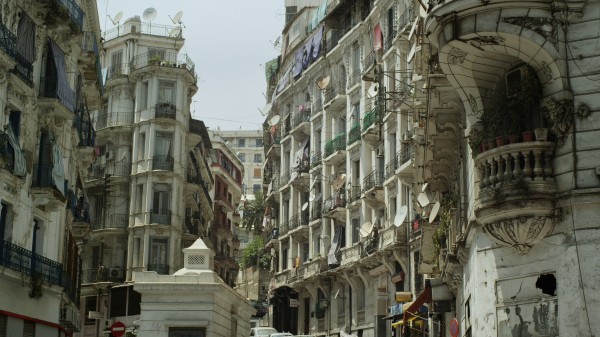
Algiers, from Perret in France and Algeria (2012)
The modernist architect Auguste Perret was born in 1874 and died in 1954. He built houses, studios, churches, and government buildings both in France and in the French colony of Algeria, then died eight months before Algeria declared its war for independence. The German filmmaker Heinz Emigholz’s new film, Perret in France and Algeria (2012), shot on trips to the two countries between March and July of 2011, shows how both sets of buildings are presently being used. In France, a largely Christian country, Perret’s churches and chapels have retained immaculate auras, placing them at a distance from everyday life; in Algeria, which became a Muslim country after winning its independence in 1962, Perret’s Cathedrale d’Oran has been converted into a public library. The air of the French concert hall Salle Cortot, maintaining a division between precisely ordered seats and the performance stage, differs from the availability of Perret’s Algerian Yacht-Club, a crumbling structure turned into a docking space for fishermen’s boats. The film makes it clear that many of Perret’s French buildings are now carefully preserved, oft-deserted performance halls, museums, and official historic sites, while many of his Algerian buildings are in constant public use.
The duality in Perret in France and Algeria—screening in New York February 15 and 16 as the opening film of the Museum of Modern Art series Documentary Fortnight—is communicated through new filmed images of the buildings and the sounds of their surroundings, without voiceover, as befits the usual style of Emigholz. He was born near Bremen in 1948, and began rendering the world artistically as a draftsman before turning to filmmaking. His early films such as Arrowplane (1974) and the Schenec-Tady trilogy (1972-1975) presented, to the tune of scores written before filming, landscapes rendered through sequences of thousands of 16mm photographs. After making a narrative, actor-driven film called The Holy Bunch (1990), he shifted his practice from filming actors in space to focusing exclusively on filming spaces themselves in a series of documentary films.
Over the past 20 years, Emigholz has made more than 80 films in the ongoing nonfiction series Photography and beyond, which uses the tools of filmmaking to present works by visual artists from other mediums, including painting, drawing, sculpture, and interior design. Perret in France and Algeria, which the filmmaker intends as one of the series’ closing films, belongs to a subcategory called Architecture as Autobiography, each of whose entries takes as its starting point the life’s work of a modernist architect or civil engineer. Each film offers a succession of individual sequences containing new images of the person’s buildings in the structures’ chronological order of completion, suggesting both how the artist’s style developed over time as well as how time has impacted his works.
A typical Architecture as Autobiography sequence begins with a title card stating an individual building’s name (e.g., Hôpital Sétif), date of completion (1934), location (Sétif, Algeria), and the date of Emigholz’s filming it (June 22, 2011). The sequence then shows the building through a series of fixed shots of individual parts of it, often taken at slightly skewed angles in keeping with how the human eye frequently looks. For instance, Sullivan’s Banks (2000), a 1995-filmed cataloguing of banks built between 1906 and 1920 by the American architect Louis Sullivan, first presents the exterior of the National Farmer’s Bank in Owatonna, Minnesota as seen from in front of a tree; the film then registers the bank from a series of vantage points along the car-filled streets outside it, glimpsing the neighboring dance school and dry cleaning shop while moving closer to the building, until an old metal sign reading “Office Entrance” appears, transitioning to an exploration of the bank’s interiors.
A similar urge to see informs a trip through Auguste Perret’s Parisian Immeuble d’Habitation de Maurice Lange, as the camera looks first up, then down during a stairwell ascent, finally arriving at a door, and then a trio of moving trees outside. The shots in almost any Architecture as Autobiography sequence link together to form small, self-contained narratives of curiosity, exploration, and discovery, with both eyes and ears taking their fill of a place. Throughout the shots the soundtracks flow richly with ambient noise from both the buildings and their surroundings, whether the dying echoes of human footfalls or the gathering whoosh of wind as it rustles through leaves.
The sound helps the viewer to imagine a greater world of which any one edifice is merely a part. “There is no point in trying to separate a building from its surrounding environment,” Emigholz says in the first scene of his architecture film Schindler’s Houses (2007), an exploration of Los Angeles homes built by the Austrian émigré Rudolph Schindler, with views of the newer curving roads and hilltop houses around them. In that Architecture as Autobiography film, as well as in others, seeing buildings within a greater contemporary urban context suggests how they continue to be relevant to it. In Perret in France and Algeria, regardless of whether the streets surrounding a Perret building are empty, as in Paris, or bustling, as they are throughout Algeria, one is always aware of people continuing to interact with a building regardless of its age, animating it and reinventing its value for the present moment.
These contemporary people include Emigholz, who has made the act of recording other peoples’ life work into his own. As his camera studies interior curving pathways that simultaneously connect and offset the clean, elegant lines of a vertical foundation, it becomes clear that his prized architects’ buildings were made to be inhabited as well as looked at. Their great beauty, his films suggest, holds practical value: it makes inhabiting them a pleasure.
How did you arrive at Perret in France and Algeria?
Between 1986 and 1990 I produced and directed a feature film called The Holy Bunch. It dealt with a group of artists, one of them dying, as well as with an elaborate set of architectures and complicated spaces, designed on a set and filmed in reality at places like at the Cologne Cathedral and La Sagrada Famila in Barcelona. I like to depict complicated, multi-layered spaces. I went broke with The Holy Bunch because I produced it myself, and was sitting with a lot of debt. So I decided to drop the actors and continue with what I liked most. I continued filming the spaces without them.
I made a list of architects and civil engineers whose work I admired: Louis Sullivan (1856-1924), Robert Maillart (1872-1940), Rudolph Schindler (1887-1953), Bruce Goff (1904-1982), Adolf Loos (1870-1933), Pier Luigi Nervi (1891-1979), and Auguste Perret, among others. In 1992 I started preparing one film, a documentary with voice-over, about these architects, their concepts of space, and my thoughts on it all. I filmed and filmed without knowing how I would edit the material. Then, around 1997, I decided to drop the overview approach.
The reason for this was that I thought cinema had lost its purpose as something that could explain the world on every level, as in a Gesamtkunstwerk [“total work of art”]. The Internet arose to provide a lot of information, so now I did not have to infest my film with that information any longer. I could spare the time and present spaces in an act of cinematography instead. Not to dramatize the material, not to put music or anything on top of it. Just to film and represent the spaces in a well-equipped screening room.
It was clear that I had too much material for one film with the works of these guys. I broke the project into several films and made a chronological order for each, a kind of catalogue of the buildings. I would edit the buildings in the order they were built so that we could see how each architect’s work developed over time. I would film the spaces, and in between the images of buildings I would include title cards with basic information: the name of the building, its location, the year it was built, and when I filmed it. My idea seemed so simple that I thought there would already exist hundreds of similar films, but I was shocked to discover that there were none. Our current historical moment’s belief that everything is available to you with the click of a button in a search machine is so utterly false. You have to make long journeys to record these spaces, and nobody had done it before.
The first three short films in the series Photography and beyond premiered at the Berlin International Film Festival in 2001. Some people said, “This is only for architects,” but I had another vision. We all have to live in some kind of building, so everybody has to think about or is confronted with what architecture is or could be, even if one doesn’t want to deal with it. I initially filmed in 35mm because of its high resolution. It was the best stock for documenting architecture. When you work in 16mm you cheat the spaces, the volume of negative space does not show – a high resolution is essential for showing it. Now we work with the RED digital camera and its high resolution, which is a relief, because we couldn’t make certain films on 35mm analogue film stock. On this recent trip we did around the world for The Airstrip, for instance, it would have been impossible to carry that equipment around. But regardless of digital versus analogue, the aim was always, from the beginning, to use the cinema space to represent architecture. This is subversive, because cinema is usually built to show something that takes place within a space, but cinema can represent spaces themselves in the best way that you can think of.
Now there are about eighty films in the series, including nine feature-length works. Perret in France and Algeria is the second-to-last film of a final group of films I call Decampment of Modernism. The first one, Parabeton – Pier Luigi Nervi and Roman Concrete (2012), premiered at Berlin last year and has not yet been released in the United States. The final one, The Airstrip, will be finished this June. Like Parabeton, which deals with both modern and ancient constructions by placing the architectures of Nervi’s modernist buildings in relation to ancient Roman structures the Perret film contains a dichotomy. The Airstrip is a compilation film, and it will sum up my endeavor with conclusions on a worldwide level.
How do you see the paths of Perret’s French and Algerian buildings diverging after Algerian independence?
I knew that Perret had built in Algeria, but I had never been there, so the trip to Algeria and the difficulties of filming there became a story in itself. The buildings there were built under French rule, then Algeria became independent, and it was moving to see what had happened to the buildings there versus those in France and how history had divided their histories into two separate tracks. I like that duality in this film very much. He built one building there, and then maybe three in France and one in Algeria. But I didn’t push their succession dramaturgically—it’s just chronological. It’s not a rhythm I created, it is created by the works themselves.
I do not say, in either case, “This is good” or “This is bad.” First, as a documentary filmmaker, I go to these spaces to record them. I don’t re-arrange furniture; I do not add artificial light; I film everything like it is. Sometimes I’m asked why so few people appear onscreen, to which I say it’s because I don’t use actors. We filmed some small streets in Paris, which were often empty. What can you do? I don’t want to make people act out living somewhere. If they feel comfortable with being in the picture, I feel comfortable with it, but either they are there or they are not. And I must say I am quite happy that they are sometimes absent, because actors can block the view of the real thing. You don’t need somebody to represent you in the picture as an onlooker—you can imagine that you are there yourself.
Perret built some artists’ studios in Paris, including one for the sculptor Chana Orloff in 1929. The Nazis destroyed her studio during WWII, and she died in Israel in 1968. Her son turned her former studio space into a kind of museum for her sculptures, which it remains today. He let us in—it’s not open to the public, but we wanted to film the building. And I was suddenly interested in her sculptures. The result is a long sequence that doesn’t deal much with architecture, because it’s a relatively simple space, but with a full sculptural population. At the end of it appears her bust of Auguste Perret’s head. I love that sequence because, no, people are not technically living there, but in a way they are—the spirits of people who once lived.
Our most populated Paris scene will be in The Airstrip. Perret designed a monument for Gustave Eiffel, who built the Eiffel Tower, which is located at the Tower’s north corner. There are a lot of people in that sequence, standing in line. But it’s generally true that in Paris there are empty streets and in Algiers there are populated streets. In Algeria, when you see the Maison de l’Agriculture, you also see hundreds and hundreds of people walking outside it. And then you see something like the Yacht Club in Algiers. If a yacht club by Perret would still exist in the so-called West, it would be posh. In Algiers, the Yacht Club is now a run-down space for fishermen to use. I’m not moralistic about what happens—I just want to show it. But for me that run-down place is a much nicer yacht club than its posh counterpart in the West could ever be.
It seems that some cultures use up their architecture. East Germany used up the DDR, sometimes destroying old quarters and building new ones. We don’t live in a museum. Different societies deal differently with architectural heritage. It’s not up to me to say what the Algerians do with their buildings is wrong and what the French do is right, or the other way around. But we can read. When we depict what’s there, I think we can very well read what’s going on.
What happens to modern buildings in time? The originators, the first owners, leave them. New people move in, and the buildings change. Some become so-called trophy houses, or masterworks. Many buildings by Schindler, Maillart, and Goff were originally single custom-made houses, built cheaply, but to renovate or even simply maintain them now would be very expensive. Labor was cheap when they were built, but now it is expensive in certain countries. In the case of Robert Maillart, the scaffolding for the buildings was cheap. The buildings were elegant concrete structures, and the scaffoldings were masterworks in themselves. But now you can’t just go to Home Depot to fix a Schindler building. If you would try to redo them now, you couldn’t pay for it. A lot of the buildings I have depicted are already forgotten, with only one building per architect taken to be the essence of his work. People rarely take the whole arc of his work, but I want to show how it began and how it ended.
The way I see that arc also changes over time. When Sullivan’s Banks was being made, many things in it were banal. But when I look at it now I see it as a documentary film about 1995, capturing things that don’t exist anymore. Goff in the Desert (2003) contains houses that were destroyed by Hurricane Katrina, as well as by other hurricanes and tornados in the American Midwest. These films work first as records, then later as monuments, both to the buildings and to their makers.
Some of these guys, like Bruce Goff and Rudolph Schindler, were always in the middle of controversy. The architectural community didn’t like them. Goff and Schindler were expelled from the International Style movement because their views were not presumed to be politically correct. They had a lot of problems with the building establishment, so they only built small household units. They never got into big business. When you make films like these about these neglected architects, you not only join a discussion, but you create an argument. However much people want to talk about what’s good or bad in architecture, when you’re faced with a 105-minute 35mm film of Goff’s buildings, you can’t just do like Mies van der Rohe did and say he built crap. You cannot talk it away anymore—you have to look. And in fact what I like about Bruce Goff’s work is how present it feels.
How do you prepare to film buildings?
It starts with me accidentally running into something. I ran into Schindler buildings in Los Angeles in the 1980s. I didn’t even know his name, but I remembered a certain space later. In Goff’s case, too, I went into a house by him in Los Angeles. I had no idea who he was, but I remembered the house suddenly when I decided to do an architecture film. I remembered other spaces suddenly, then started researching, then at a certain point looked at images and decided to travel to their sites. In 1991 I went into a bookshop in Venice, California, and found a book with photographs of Louis Sullivan’s banks. At that point I was thinking a lot about modernity and the ornament and the free-hanging façade, rather than a façade that carries a building. That has been possible in modern architecture since the end of the 19th century. As the façade doesn’t carry something, the possibility exists of doing free design on it. Louis Sullivan worked a lot with these new possibilities. The book addressed my own interests, and I thought, “I have to go there. I can’t rely on these photographs. I have to see it myself.”
I didn’t do a research trip before making Sullivan’s Banks. I went with the 35mm film camera for my first in-person view. Afterwards I received a shock about the procedures of architectural still photography. Sometimes I didn’t recognize a building from these photographs, because the still photographers, who have little space in their publications, use wide-angle shots to get the whole thing into their images. My films use normal lenses to give the view you have when walking through the space. The field trips are the most important part of the work, and they are very satisfying. You can’t do a scouting trip to Algeria because they don’t let you into the country beforehand, so in that case I came with a list of buildings and I found some more while I was shooting there.
I love shooting. I love making decisions all day long. My mind works very well when I am on set. I have to clear it to be ready to work, and then, when I am concentrated enough, I might be lucky enough to get what I want. I can’t write a script, like “It should rain. Rain fits that building well.” That would be ridiculous, because it might not rain for two years. So I have to react to what is there on an unforeseen day.
Preparing for this is important. But the first stage of preparing a shoot is dealing with complicated spaces and seeing the relationship between your thinking and somebody else’s in them. I felt grateful for these architects’ work. Bruce Goff’s and Adolf Loos’ buildings were sometimes hard to find because they were not well publicized, but it was always wonderful to find a building in its surroundings. The deeper I’ve gone into the series, the more important the buildings’ surroundings have become for me. Perret and his group of architects reconstructed the whole center of the city of Le Havre, so those scenes in Perret in France and Algeria feature everything. But in Algeria, many shots do not even contain a Perret building. Sequences go on for seven or eight shots before a Perret building appears because I was interested in the city life surrounding it.
How do you decide to present the environments around the buildings?
The larger documentary series in which Architecture as Autobiography is a part of is called Photography and beyond, and what I mean with this is that the series is about what your mind reads from your retina. So when, for instance, in this architecture subseries, you take a space that is already designed, you then construct your images with something that has already been constructed, which includes the natural or man-made world within and around it. My construction is a labor of love and not of criticism. I like the architects whose works I depict. They are geniuses at creating three-dimensional spaces. I couldn’t do that. I consider myself, rather, a specialist at putting three-dimensional spaces into two-dimensional imagery. My architecture films present a double-coded construction, each film creating a composition on top of someone else’s composition.
We put as much work into the film’s soundtrack as into the images. We record synch sound while shooting images, but afterwards we also record all the noises present both inside and outside the spaces. We then create the whole sequence by layering sound after the images have been edited. We don’t want to add artificial effects or music, because so much is already there. Even silence—each room has a different silence. And the off-screen space enters the image through sound.
When I first started showing these films some people said, “These are slide shows. These are silent films.” That’s total bullshit. When you look at something very deeply, you also hear it. Furthermore, you discover that there is a time-based aspect to your hearing and seeing. It’s not photography, because photography represents only a short moment, a one-hundredth of a second, while film is a container for a larger piece of time. Some people don’t see movement, but in every shot I see something moving, even if it’s only the air.
How established are your sequences before filming?
My idea about filmmaking is that each shot has to be perfect, and then we build from there. I don’t want to use shots that just fulfill the function of connecting to other shots. Every shot has to be perfect first in itself, and when I film, I care for that. The sequence is not in my mind, save for thinking about how to connect specific images to each other. There are always parts in one image that reappear in another image, so I make the connection then. But I don’t have the sequence in my head when I film. I have the whole building in my head, and at a certain point I say, “Now I’ve got it.”
I don’t know how I will go through it—whether I will go in or out or up or down. I will decide that in the editing process. But the images have to be composed. In themselves they have to be perfect, and they have to have connection possibilities to other images surrounding them. That is very different from architectural photography, which produces images that don’t connect: tableaux. When I create a film sequence I have maybe sixty shots, and I can build a complicated space with them and then connect it to others. But I will never present a sequence of stand-alone tableaux.
Furthermore, I don’t have specific shot lengths in mind when I film. The length of my gaze is intuitive. There’s no mathematical rhythm. It’s always about how long I look, and for how long I see something interesting in the picture plane. Some pictures are more complicated than others, and so they get more space and time. But I often rewatch these films—I’m a viewer myself—and I always see something that I didn’t see before.
What have been your greatest surprises in making the architecture films?
After I began shooting, when I still had the idea of doing only one film, I got into an editing block. I felt satisfied looking at how the material came out of the camera and didn’t see the necessity of editing, so I said, “I don’t want to add anything. I just want to look at it as it is.” I liked what I saw, and had to deal with it. The spaces themselves made me rethink how I wanted to present them.
All my architecture films are made with more or less the same strategy—I go to a space, I film the buildings there, and then I edit. But each film develops a different mood. When I see Loos Ornamental (2008), I get a sense of depression over how it all ended with the Third Reich in Austria after 1933. And in Schindler’s Houses, by contrast—even though the two architects basically worked at the same time, and even though I basically use the same methods to present their buildings—you get a different feel for somebody who lives in another country and is able to experiment with greater freedom. I add a certain kind of photography to the buildings, but I’ve learned that when you let these buildings speak, they will. You don’t have to do it for them.
I do have voice-over commentary in The Airstrip, but only in Duty Free areas at airports. There will be a lot of voice-over, but only when I go into surroundings that I don’t like, as in my trip to the home of the writer Gabriele D’Annunzio (1863-1937) in my earlier film D’Annunzio’s Cave (2005). When I show something I like I don’t talk anymore, because the objects speak for themselves.
As I said, The Airstrip will be the last in the series of architecture films. One reason why I am stopping is that it is getting more and more complicated to do this type of film. I wanted to make a film on the architect Luis Barragán’s (1902-1988) buildings in Mexico, but I was not allowed to do so, because the so-called picture rights to those buildings belong to the Barragán Foundation in Switzerland—owned 100 percent by the design company Vitra —and they wanted 30,000 Euros. It was shocking for us, because we thought we would do a service for his legacy. No, they want to make money. We went to Mexico City and filmed three of his public sculptures for which they don’t have the picture rights, but in general I fear that documentary films will become impossible to do as capitalist organizations invest in virtual picture rights and prevent those studies. Even some architects, who have made their buildings to be seen only from certain angles, will tell you from where you are exclusively allowed to film them.
This is a new topic, and one has to think about it. You can do millions of photographs of a three-dimensional situation, but if somebody suddenly says they have the picture rights to that situation, it makes documentation impossible. If this goes on, the world will no longer be recordable, as every clown with money can say, “I will call the police if you film this.” I want to turn around and ask, “Do they have to pay me if I don’t like their buildings and they hurt my eyes?” It’s more than disgusting, it’s active censorship perpetuated through capitalism. What happens is much worse than in Algeria, where the police didn’t bother us once we explained what we were doing. The Algerian people didn’t want money.
Which is good, because we didn’t have the money. It has been very hard to produce these films, partly because it’s hard to show them on television. We have shown some on TV, but the producers have always had problems because nobody says anything in the films, there’s just image and sound, and TV nowadays is radio. They want somebody to talk, otherwise you hurt the basics of their media.
Video recordings are very cheap now, and TV people from organizations like the History Channel can quickly pan around and ruin all prices, so that making a decent work becomes unaffordable. I was pleased to see the audience for Photography and beyond suddenly grow after about ten years—Parabeton had an eight-week run at a very good movie theater in Berlin—but it is getting harder and harder to produce these films at a sufficient level. And I don’t want to deal with crap like picture rights and TV’s subpar standards anymore.
What does Architecture as Autobiography mean?
Some people write their autobiographies, and some build them. I think the spaces themselves, if you look at them, tell you something about the way that their builders thought about space during their lifetimes, as well as what they could actually achieve. Most people think an autobiography has to be written, but it can be represented through buildings, and you can read these buildings. You have to read what you see: what did he do with that space, and why did he do that in that time
For instance, the Bauhaus guys ripped off a sentence from Louis Sullivan: “Form follows function.” To them, this meant only one form for each function, which is bullshit, because Louis Sullivan’s position was that a function allowed millions of forms. You might look at Sullivan’s buildings and discover that are they all different from each other. If there’s only one form for a function, they would all look alike, but they don’t. There are different qualities to each.
How are your architecture films autobiographical?
When I look at them and read that I was in a special place on a special day, I think that it made sense in my life to be there doing that work. It’s a kind of diary. Now there are so many films, made over 20 years, and I would like to see them all one after the other and get overwhelmed by these spaces, because after a while I forgot where I have been in my lifetime.
More information on the Photography and beyond series can be found at the website for Heinz Emigholz’s production company, Pym Films.
This interview was conducted at last year’s Toronto International Film Festival, where Perret in France and Algeria screened as part of the Wavelengths program. Thanks to Emigholz’s Canadian publicist, Stephen Lan.
]]>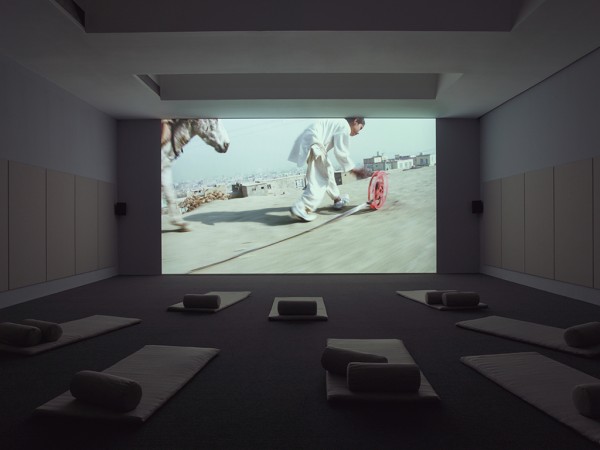
image courtesy of David Zwirner Gallery
I’ve read many thoughtful discussions of whether Zero Dark Thirty, the new Hollywood depiction of the United States government’s hunt for Osama bin Laden, endorses torture. I’ve read few discussions, period, of whether the film endorses the Afghanistan War. This tendency to question particular aspects of how the war has been fought rather than the nature and purpose of the war itself follows the greater American media’s lead. Unlike the initially stated reasons for the Iraq War, which common wisdom came to approach as lies, the goals of the Afghanistan War were always simple, clear, unchallenged, and morally unambiguous: Get al-Qaeda. Get bin Laden.
But how much damage has the longest running overseas conflict in U.S. history done in the name of these goals? Let’s assume a few things to make our estimates conservative, and then see. Let’s assume that the States did nothing to provoke the Taliban’s attacks, and ignore how the CIA’s support of the anti-Soviet group during the Cold War helped the Taliban come to power. Let’s also assume that the government was innocent on September 11th, neither collaborating with al-Qaeda to aid the attacks, as some have suggested, nor discovering signs of the attacks months in advance and neglecting to do enough to stop them, as the 9/11 Commission Report overwhelmingly shows. Let’s then look at these statistics, courtesy of Wikipedia:
Number of people killed in the September 11th, 2001 attacks: 2,977
Number of American soldiers killed in the subsequent Afghanistan War: 2,110
Number of Afghan civilians killed in the war: Between 7,300 and 13,800
The first number is self-explanatory. The second does not account for suicides, which currently outnumber combat deaths, and the third does not account for people who have died of starvation, disease, or any other non-artillery consequence of the U.S. invasion. But even if we stick just to deaths under fire—further excluding the many people who lived through September 11th while suffering permanent physical and/or psychological damage, and the many more who have suffered them as a result of the war—we still must conclude that the American government has avenged the innocents killed on 9/11 by sacrificing nearly three-quarters as many of its own people, and killing, at minimum, more than twice as many innocent Afghans.
We don’t have a more accurate count of Afghan civilian casualties for many reasons, one being—as Zero Dark Thirty briefly alludes to—that American soldiers often haven’t been around to count the bodies. The U.S. military has increasingly phased out ground combat in favor of drones whose bombs are dropped by pilots seated in military bases in front of radar screens, often thousands of miles away. As a result, horror stories abound, if one looks for them, of wedding parties blown to bits, and family members killed while lying beside each other asleep. When Zero Dark Thirty’s CIA agent Maya (played by the beautiful, appealing star Jessica Chastain) snarls that she’d like to drop a bomb on the compound potentially containing bin Laden, she—as well as anyone who shares her view—is ignoring the bulk of the people who would come to harm.
The film tells the familiar tale of the Afghanistan War as a revenge fantasy. The loner Maya devotes years of obsession to bin Laden, then weeps after seeing his corpse. She no longer has someone that she wants other people to kill for her. For some viewers, perhaps, the sight of her tears might inspire pity. But if we want to learn about how the war has actually been run, and who its greatest casualties have really been, then we should look elsewhere.
One good source of information is the new omnibus film Far from Afghanistan (showing in New York next month as part of the Museum of Modern Art’s series Documentary Fortnight), which analyzes the war’s global impact by drawing connections between the decimation of Afghanistan’s general populace and the decimation of the American middle class. Another is Malalai Joya’s 2009 book A Woman Among Warlords, in which a former Afghan Parliament member speaks out against both her country’s corrupt leaders and the American efforts to keep them in power. They both strongly counter the easy Hollywood stereotyping of Afghans as terrorists, co-conspirators, and helpless victims awaiting American rescue. So does the artist Francis Alÿs’ 20-minute video REEL—UNREEL, made in collaboration with Julien Devaux and Ajmal Maiwandi and on display through February 9 along with several Alÿs paintings at New York’s David Zwirner Gallery, as well as available for free viewing on the artist’s website.
The video was shot in November 2011 (the month after the war’s 10th anniversary) on a commission from the art exhibition dOCUMENTA, as part of a Germany-Afghanistan cultural exchange. Its stated purpose is to counter negative images of Afghans in the Western media. If this is true, then we might look to the New York exhibition space itself as evidence. The entryway’s walls contain paintings of color bars, like you might see when adjusting your television; some paintings consist entirely of bars, while others collage them with photographs of people and buildings. The artist has said “I cannot paint violence,” and these canvases can be seen as rejections of the violence that audiovisual screens so frequently show. Yet the colorful, symmetrical stripes can also be seen as adding something positive to counter negative imagery, especially in the paintings that show Afghan civilians gathered around them. When we look at a group of women seated in front of the bars, or even the bars looming over the rooftops of the city, we see people transforming the world in front of them. The rectangle ceases to transmit others’ stereotypes, and becomes a screen onto which its viewers project themselves.
Alÿs’ past work has often made entertainment out of the everyday, transforming reality through imagination. In some works the artist has even literally collapsed political and geographical boundaries by repainting national borders or carrying water from one sea to another. The 53-year-old Belgian artist forgoes direct political commentary in favor of what he has called “a sort of discursive argument composed of episodes, metaphors, or parables.” One of his most celebrated videos, Paradox of Praxis 1 (Sometimes Making Something Leads to Nothing) (1997), shows him dragging a large block of ice through the streets of Mexico City, where he has lived since 1986. At first the piece seems like a straightforward joke on the constant burden of work—a point that is sharpened by passerby ignoring the workingman—but Paradox sweetens as the ice melts into a ball small enough for the man to pick up and work transforms into play.
In many of his videos, either Alÿs or a stand-in abandons adult responsibilities for childlike game playing. Since 1999 he has worked on a video series called Children’s Games. The brief pieces, typically intended to play as loops, were inspired by the realization that children’s games were fundamentally alike across the world, coupled with the desire to record these games in urban landscapes before urban development made them disappear. Each video takes its title from a game’s chief objects. Coins (2008) sees young Mexican boys bouncing money against a wall; Saltamontes (2011), the Spanish word for “grasshoppers,” shows Venezuelan children plucking the legs off of the titular insects and throwing them into the air to see how high they can fly. The films show their objects being transformed into toys through children’s imaginations.
Alÿs has made three Children’s Games films in Afghanistan, one of which can be seen as a direct precedent to REEL—UNREEL. On his first visit to Afghanistan, the artist noticed the most popular children’s game to be rolling a hoop with a stick. The Children’s Games film Hoop and Stick shows a young boy playing the title game. The opening of REEL—UNREEL develops this image, as two young boys on the outskirts of Kabul chase their hoops while a third examines a filmstrip. Soon one of the hoops goes flying off into the canyon. The boy, in looking after its path, sees a helicopter flying above him, and frames it with his hands.
A few shots later, a boy in white rolls out not a hoop, but a bright red film reel. Another boy dressed in black soon appears rolling a cool blue one. A flock of other boys run joyfully after them. As they race along roadways and through alleys, a balloon man holding a multicolored array follows them, suggesting that films, too, are toys to be played with. The brief visual reference to the classic children’s film The Red Balloon (1956) suggests that real life might be as much fun as the movies.
Life might become even more fun, in fact, as the city around the boys gets wrapped up in their play. As celluloid spools out of the canisters, we bounce with the boys and toys down hills, absorbed in rapid motion. The sounds of panting are soon joined by those of car horns honking, motorcycles grinding, and radios playing pop music. We’re in the middle of crowded road traffic, then in the middle of a mess of human traffic, as the film cuts out to reveal a flux of movement within a market square. The boys are lost amidst men wheeling onions and driving with enormous white bags.
One of the pleasures of Alÿs’s video lies in watching quotidian Afghan life in motion. What we see in the market are simply people making it through the day. As celluloid falls from the boys’ canisters onto the ground, two women select fruit and nuts to buy, and a pair of young men stride together laughing. Other people push carts, or ride bicycles. In contrast to those whose identities have been permanently, reductively defined within film frames, everyone in the square is animated.
The boys continue rolling, taking in more of Kabul’s Old City, including other boys kicking a soccer ball, absorbed in sport just like them. Eventually they reach another mountaintop; the blue reel goes flying off the hill, like the earlier hoop, but it might not matter. The boy who’s lost it looks out and smiles at the sight of innumerable buildings below him. They form part of a culture richer than any one depiction of it.
We’ve seen small pockets of fire burning celluloid along the path back up the hill. Arabic-language title cards appearing toward the video’s end tell that on September 5, 2001, the Taliban burned thousands of reels of film on Kabul’s outskirts. The arsonists didn’t know, however, that they were primarily burning copied prints and not negatives. REEL-UNREEL lets us think about images of Afghan life being destroyed while the originals remain. We then once more watch the boys, who will soon leave this filmed vision of Afghan life to find whatever other joys their lives afford.
Note: According to a story in the January 7 issue of The New Yorker, Alÿs has recently begun work on a video of former mujahideen assembling and disassembling an AK-47. He plans to return to Afghanistan to film an American soldier performing a similar activity because, he says, “I want to understand it from the other side.”
]]>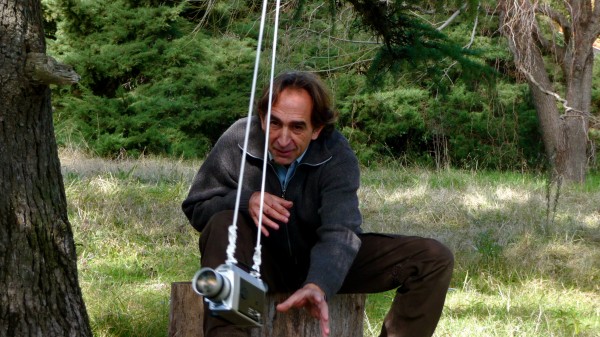
Claudio Caldini in a scene from Andrés Di Tella’s Hachazos (2011)
This interview with Andrés Di Tella was conducted during a retrospective of Di Tella’s films at last year’s edition of the Brazilian documentary festival It’s All True. All quotations from Di Tella’s book Hachazos were translated by Aaron Cutler from Spanish to English. All images courtesy of Di Tella unless otherwise noted.
***
A man brings all his work, all his life, inside a small leather bag purchased in India, on a train that goes from Moreno to General Rodriguez, by the western suburbs of Buenos Aires. They are the originals of his films, all in Super 8, an obsolete format, in danger of extinction, which does not allow the films to be copied. This bag is like the manuscript of his autobiography. It tells of Claudio Caldini, caretaker of a suburban villa, secret filmmaker.
These words open Andrés Di Tella’s 2011 book, Hachazos, which he calls “the diary of my encounters with Claudio Caldini.” The book’s subject is one of the survivors of a rich group of Argentinian experimental filmmakers who blossomed jointly in the 1970s, during the years of Argentina’s military dictatorship. (The nation resumed free elections in 1983.) Caldini’s films—twelve of which were digitally transferred and released on home video along with films by his compatriots last year through the boutique label antennae collection breathe like brilliant bursts. They are built with simple, repeated gestures, rendered in pulsating color: lit candles glide from front to back of a dark frame in Aspiraciones (1976); the bright green of leaves on branches soaks the screen as plants dissolve over each other in Cuarteto (1978). Sometimes, as in Gamelan’s (1981) fusion of a camera’s steady circular swing with a Steve Reich piece, the films are explicitly set to music. Their progressions of rhythms intensifying until reaching crescendo are always musical, regardless of whether the films have soundtracks. These are perfectly formed compositions.
Caldini’s life outside cinema has been far from one. His countryman Di Tella’s book tells—to the extent that its often closed, distant subject will allow—of how Caldini, dissatisfied aesthetically, politically, and spiritually, left Buenos Aires for the utopian ashram of Auroville in India. He ensconced himself so completely within his new community over the following six months that he was unable to readjust to Argentina upon his tourist visa-mandated return. He stayed inside his parents’ villa, then was sent to a mental institution, and closed himself within a series of walled spaces, including further trips to Auroville, throughout the 15 years that followed. The most sustained effort he made during this time—when he could make it—was filming. On his last trip to Auroville, he shot Heliografía [Blueprint] (1991), a record of a circular bicycle tour throughout which one senses the artist’s ghostly presence. Di Tella writes how, for him, the film sums up Caldini’s interest in exploring both nature and his perception of it: “The observer is part of what is observed and his gaze modifies what is seen.”
Di Tella could also be describing his own films. The half-Indian writer was born in 1958, six years after Caldini, and first met Caldini in the 1970s through his Hindu mother. Di Tella became a documentary filmmaker whose work has increasingly explored the tension he feels between himself and his very personal subjects. (Di Tella also founded Argentina’s largest film festival, BAFICI, in 1999, though he stopped working for the festival soon afterwards.) His early documentary, Montoneros, a Story (1994), a rigorous piece of journalism in which former members of Argentina’s strongest anti-dictatorship guerrilla movement recount life on the run while their faces betray both the pleasure and the exhaustion that they still feel from it, contains the filmmaker’s supportive feelings only implicitly. By contrast, his love for his subject is everywhere in the following year’s Macedonio Fernández (1995), a portrait of an Argentinian writer whose fictions inspire Di Tella’s film to create its own, including the possibility of having the author’s voice on tape. His love complicates The Television and I (2002), which begins as a search for the Argentinian television he missed while living abroad as a child, but becomes a series of discussions demonstrating his awkward relationship with his father, a television manufacturer, and a questioning of how his young son will grow up to feel about him. In Photographs (2007), Di Tella stretches himself even further. He gathers scattered documents to try to reconstruct his memory of his long-lost mother, then travels to India to meet relatives he’s never known, who tell him that they didn’t really know her either.
Di Tella interviewed Caldini for Photographs, though the footage ultimately was not used. In the decade following his last Auroville trip, Caldini moved through 36 different homes without steady work, finally settling down as the caretaker of a suburban villa. From 1998 to 2004 he served as the film and video curator at Buenos Aires’s Museum of Modern Art. He also, in time, began teaching a filmmaking seminar, found three Super-8 projectors, and transformed his art. What were once films became parts of performance pieces, with Caldini operating multiple projectors simultaneously. As part of the Hachazos project, Di Tella collaborated with him on several, performing research like transcribing interviews and reviewing photographs onstage while Caldini worked with his films. Di Tella eventually decided to make a film in collaboration with Caldini, though he knew that the work would be difficult. As he writes in Hachazos about the upcoming film:
The interesting thing about the project would be, certainly, that it would deal with two very different filmmakers, who incarnated two almost antagonistic conceptions of cinema. Narration and contemplation. Testimony and image. Figuration and abstraction. There was the conflict. It would not be a documentary about Caldini but a film made with Caldini. The record of a collaboration, a correspondence, a discussion.
Though Di Tella’s films are often both digressive and comic, his subjects determine their ultimate shapes and styles. Hachazos (2011), a companion piece to his book of the same title, is filled with long pauses and the sound of breathing, as Di Tella’s camera sits in close-up on Caldini’s face, waiting for him to speak. The film unfolds over a few days at the villa where Caldini works, as Di Tella tries to convince him to retell his story. Again and again, Caldini shrugs him off, saying that Di Tella is turning him into a fictional character. Di Tella doesn’t much disagree, and even goes so far as to enlist Caldini in staging literal reenactments of his filmmaking, with the older man once again swinging a camera from a tree and riding a bicycle in a circle.
Hachazos shows Caldini becoming a character in a story Di Tella is telling—a man whose life is incomplete without cinema. The closest we come to glimpsing this man’s inner workings is when we watch his films projected. It’s when Caldini projects pieces of Un nuevo dia (2001) —a reconstruction of a “disappeared” friend’s lost film made entirely according to his memories of the original—for Di Tella that he most fully shares his recollections of the dictatorship years. As he projects his films for his students, we glimpse the peace he has long sought.
A moment in both the Hachazos book and film shows Di Tella trying to read Caldini’s face after Caldini has described a dream he’s had. The dream is about living in a house that isn’t his; Di Tella speculates whether “the work of any artist, in any circumstance, is anything other than an inventory of his or her attempts to return home.” This speculation circles back to the project’s title, which in English means “Blows of the Axe,” and refers to the 1950s practice by Argentine distributors of chopping up film prints to prevent people from stealing and illegally projecting them. Caldini’s father, an electroplater and amateur film buff, would collect these film fragments and project them for his family at home. The Hachazos project, years later, shows both Di Tella and Caldini making art to project a fragmented past.
Often in documentaries, the story is told through archival footage and talking heads appear to flesh that footage out. In your movies, though, that seems to be flipped. Often it seems you’re presenting the past through archival footage, but the story is really in someone’s present-day face. Why?
I hate the idea of archival footage just illustrating what somebody’s saying. Often that’s the case, and I like to work against this practice. For instance, Prohibited (1997) uses the most archival footage among my films. I used news footage and official ads from the time of the military dictatorship in Argentina, but I was adamant that the footage would always appear with the effect that you were watching the thing in its entirety, for itself and not to illustrate something else, nor to be illustrated by someone else. I would sometimes leave the rough edges at the beginning or at the end, to give the feeling that you were watching the piece in its entirety, even in cases where I had edited quite a bit on account of length.
Still, I feel now that Prohibited’s narrative rhythm possibly pays the price for this. Montoneros, a Story is a different example. That film was originally made for TV in two 45-minute segments. It was a reaction against the format of the documentaries that I had been making for PBS, which were very, very anonymous and conventional, falling in line with archival footage of people talking and a narrator explaining everything. Here, we managed to give the few short pieces of stock footage that we had—it’s very difficult to get ahold of Argentinian stock footage in Argentina, and impossible to even think of buying international material—a narrative role in the film. They’re telling part of the story themselves.
I have to balance the facts that I want to be included or conveyed within the story that I’m trying to tell, because I’m telling stories, ultimately. Every moment that there’s somebody in front of the camera, something has to be happening. The moment must be alive. So I have to find some kind of unstable equilibrium between the fact that I need to tell a story and the fact that each particular moment has to have some life in it. People have to be vividly evoking something for themselves. Something has to be happening in a person’s face onscreen.
What interests you about Claudio Caldini’s face?
Caldini is somebody who can remain silent and make long pauses and remain somehow composed in front of the camera, which is a challenge but also a gift to the filmmaker. He is somebody who withholds a lot. This could be a disadvantage, and sometimes it is if you’re trying to make him tell a story and he won’t or can’t. But the fact that he will stop in the middle makes for a great documentary character, because at that point it invites the viewer in. One of the things you’re always looking for in documentaries is a way to allow the viewer in, not to have him just listen to a lecture. I tried to give Caldini a certain mystery as a way of providing doors through which viewers could enter. The less you give away about a character, the more the viewer has to imagine. And how does the viewer imagine the character? Through his or her own emotions and personal associations. I think that the viewer can thus try to imagine what is going on in Caldini behind his face.
How did you decide you would show his films?
Hachazos is not just a film but also a larger project, which includes a book. The project actually started as a piece of writing, with a strong biographical strand. Only subsequently did it develop as a film, which is far less biographical in its content. In between the book and the film, we jointly staged a series of performance pieces, with some theatrics, where I evoked different phases of the documentary process—reading documents, listening and transcribing interviews, reviewing photographs. And Caldini, on stage, would screen some of his material by operating multiple projectors. It was an odd kind of “live documentary,” made in the physical presence of its subject.
For somebody who’s only going to see the film, however, who’s never heard of Caldini or seen his work–and that´s the vast majority of the intended audience—the film has to work on its own terms, as a story. This film is not meant for experimental film buffs. The fact that Caldini is an experimental filmmaker, outside the conventional idea of what a filmmaker is about, is of course essential to the story. But in a way it is also almost incidental. He’s a filmmaker. He’s an artist. That´s what matters, as well as how, in a way, he’s a mirror for me.
But still, I had to show some of the work he has done. At one point I was thinking that it was impossible to include clips of his films, because I felt that the real experience of watching a Caldini film is actually in Super-8 projection, and even more so when it’s projected as he does in his performances, with three or four simultaneous projectors—he’s there, and the film gets stuck in the gate, and he has to cut it, and he’s sweating his head off. And that’s really where the magic lies.
So I knew that I would never be able to convey within my film the power that Caldini’s films have for me. But somehow, I needed them, because otherwise people might think that he was just a gardener. But I think that the film ultimately conveys Caldini´s uncompromising personality in such a manner as to convince the audience that what he’s doing is dead serious, however little you are allowed to see of it. What I did was to place his films within the context of an improvised screening that he was doing on a blanket inside his house for a small audience. We don´t see film clips, we witness a live screening. It’s just another scene within the film. It’s much more intimate. And it’s part of the story.
There’s a moment when you’re filming him during the last projection of his films and he’s blocking the middle of the frame.
Yes, because it’s a performance. And he’s part of the performance.
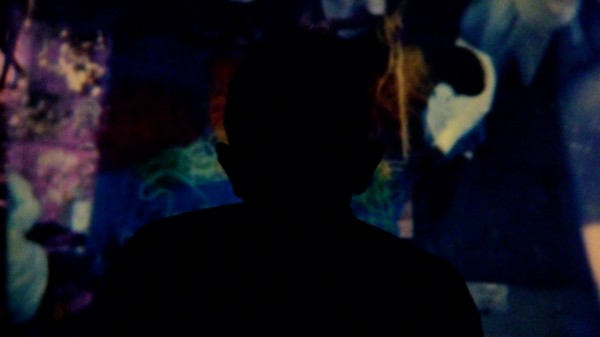
Claudio Caldini projecting his film, Tamil Nadu View (2010), May 2010. Photograph by Andrés Di Tella.
Hachazos’s most prominent sound effect is the whirring of a film projector. Why?
Partly because we were watching films all the time, and it was there. But there’s something nostalgic about its presence, too. Caldini is a fetishist about the materials of film stock and celluloid. I’ve never been—for years I’ve been shooting on tape, and then cards, or whatever it is that we shoot on now—but I do see something precious about the lost film world. Caldini is just the tip of that iceberg. He always considered himself a filmmaker, and never considered himself a visual artist, but 99 percent of Argentinian filmmakers today would not consider what Caldini does to be film. They would be happy if he said, “No, I’m doing art.” To me, though, connecting the identity of a filmmaker to the physical material of film is very moving.
Although I don’t partake in craving the material sense of celluloid, I do find that the loss of the experience of seeing films projected in a communal setting has impacted my life. Most of the films I see nowadays are on my computer or on TV. I hate for people to see my films in these contexts—I always thought that they were meant for the cinema, in the dark where you can concentrate and let your emotions work, whereas TV is the remote control. And yet the small screens are certainly where most people see my films. So you can be religious and say, “No, film must only be seen on film,” so Caldini’s films should only be seen in Super-8 projection in the dark, with Caldini himself projecting. And yet some of his films are on YouTube, and they have been released on Blu-Ray in the United States, and though he’s not entirely happy about this development, people get to see them. Some might be indifferent to what he’s doing, and some might say, “Wow.” And there’s hope in that.
How did you understand your own character’s role in the Hachazos story?
I say at one point that Caldini was the first filmmaker I saw in action. So he has always had this important symbolic dimension for me. I was still at school and he was shooting a performance by Marta Minujín, an important Argentinian pop artist who happened to be a friend of my mother’s. Minujín’s performance, called Autogeografía [Autogeography], consisted of symbolically burying herself alive. This was quite strong stuff in Argentina in 1976, when the anonymous corpses of victims of clandestine military repression were being buried by the hundreds. Caldini was shooting on Super 8 and I was throwing dirt on Minujín. This Super-8 footage appears toward the beginning of the film Hachazos.
In the rest of my film, Caldini is Caldini, the real person, but he’s also a bigger-than-life character in this story that I’m telling, and I wanted to make it explicit that I’m creating a character. To tell a story, you need a character, and a nonfiction character will always be a reduction or a magnification of a real person. I think that there’s a two-way phenomenon always happening with documentary characters. On the one hand, you’re inevitably reducing people, cutting out hours of footage, not to mention all that you’ve never even been witness to. So, in this sense, we’re a little bit like head-shrinkers. On the other hand, you’re paying so much attention to the slightest movement of a face, or to wordless breathing, and you’re working on the edit for months, striving to convey significance to each moment, that the character takes on a kind of monumentality. Suddenly it’s like you’re on Mount Rushmore! Making a documentary is always about navigating this mixture of head-shrinking and Mount-Rushmorization. The construction of this Caldini character, as with all documentary characters, is a work in process.
That’s why the discussion we have in the film over the symbolic nature of Caldini’s bag becomes so important. I saw that he had brought along all his films inside an old leather bag. You must remember these are all films shot on reversible Super 8, so that there are no negatives or extra copies, just the original prints. So I wanted to shoot a scene of the bag on the train. It seemed an appropriate symbol, both of his itinerant life and of the fragility of the artist and his work. But he refuses to play along. I saw the bag with the films. But he says that that only happened once. Does the fact that it only happened once make it untrue? Is it not representative, therefore not real?
Including the conflict over the bag was a way of pointing to the conflict in all documentaries between storytelling and reality, fact and fiction. Caldini himself says at one point: “This is fiction. This isn’t something that I would do. I don’t feel comfortable doing that.” There are other points where he says, “I don’t think this conversation is going anywhere,” or “It’s not organized properly.” I value comic timing very much, and I think it’s welcome in documentaries, especially this quirky thing where sometimes you don’t know if it’s supposed to be funny or not. So, on a basic level, the scenes are funny. But I really put those moments of disagreement in to show a tension between the real person and the character in a story. Like the bag, the Caldini of my film is torn between the man and the symbol.
My own character—the “filmmaker”—has an important function as a stand-in for the spectator. In a way, the question of the film becomes: why am I interested in this man? My character is looking for something and possibly finds in Caldini something other than what he was looking for. There is no pretense at objectivity. Often in documentaries the relationship between the people making the film and the people being filmed is hidden. And sometimes this raises an ethical concern, which is why is that relationship hidden? I wouldn’t go so far as to say the stuff behind the scenes is the most interesting—it has to be in homeopathic doses, because it can be too much of a good thing—but what’s really happening in a documentary is the development of a relationship between the filmmaker and the subject.
As a result, there’s always a little bit of “meta” in my films. I must confess that I am always curious for making-of stories. I often prefer books about how a certain book was written over the original book itself. For instance, I recently bought Boswell’s Life of Johnson, and I had a hard time plowing through it. Then a friend said, “You have to read the book about Boswell, which is much better.” It’s a wonderful book about the making of The Life of Johnson, and it helped me. I have this unhealthy appetite for the how it was made, both in other people’s work and in my own. Hachazos is autobiographical, as is Photographs (2007), both of which are films that are reflexive about the filmmaking process, even to the point of using outtakes. There’s one moment that I particularly like in Photographs that happened because the cameraman Victor Gonzalez had either forgotten to turn the camera off or accidentally turned it back on. He was cleaning the camera lens and complaining about the fact that I was late. We’re on a shoot in India and the director is late! You only catch half of what he’s saying, because the camera’s out of control. And that scene, to me, conveys my situation of being in India, trying to make a film about my family, feeling jetlagged and in a feverish state, unable to organize a film around what I wanted to do, more than anything else that we shot. The moment was a mistake, something that should have been thrown on the cutting room floor, and yet it was alive, and it was saying a lot about what was happening.
So I never use this background making-of material just for its own sake. It’s always telling part of the story. These discussions between Caldini and me over how he’s being represented in Hachazos go to show you that it’s not just his story. It’s also my story, as well as ours.
How did the collaboration between you and Caldini work? How did you shape the film together?
That’s a very good question, but it’s not easy to answer. Part of the process went simply as it does in any documentary. You propose something and the other person accepts it or turns it down, or he may propose something that you are interested in or not. Sometimes, even if you don’t like the person’s idea, you film it in the interest of placating him or her, and it may surprise you. In this case, I suggested we reconstruct how he shot his old films because I basically didn’t know what we were going to shoot besides his work as a gardener! But I suspected that something might come of it.
What Caldini does, when he’s making a film, would not be recognized by most filmmakers as pertaining to the same activities that they pursue. That’s why I thought it would be interesting to see him hanging a camera from a tree or swinging it over his head like a lasso or shooting from a moving bicycle. At one point he had been painting Super-8 frames in ink and I wanted to show him washing his hands afterwards. But he refused to let that be included because of the calamitously messy state of his bathroom. To me, the bathroom was evidence of how he didn’t care about material success, but to him it was possibly humiliating. In general, he was very happy for us to be there making a film about him, but he was not happy to be portrayed as the caretaker of a villa. He wanted to be seen as a filmmaker. But he was both things.
He had some other objections to the film of Hachazos, like the sequences not respecting the order of the seasons or there being too many cuts—points that conflicted with his own ideas about filmmaking. But I think that one of the major things that he didn’t like was that the film was showing something that he wanted to hide, even though he had let us in. In my experience, people have very strange ideas about what a film is going to do, what it’s going to show and what’s it going to tell. They always imagine something, but it’s a secret, like a secret desire that often remains hidden even to themselves. And it’s rarely the same thing that you have in mind, no matter how much you’ve explained your aims. I think that documentary subjects believe that they will be able to control the film much more than they can. I mean, I can’t control the film that much myself, even though I spend months trying to make it mean one thing and not another. But I am also learning to let go, to let the film tell me what I have to do.
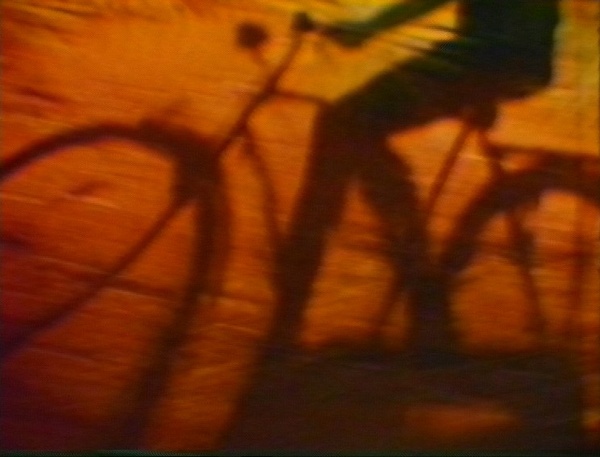
Image from Claudio Caldini’s Heliografía (1991) (Image courtesy of Centre de Cultura Contemporània de Barcelona)
With all that said, I worked with a lot of trust, which came from the investment in hours and hours of being with this guy and talking and writing, and so Caldini wasn’t nervous. For me, trust is basic. But even within that trust, the other guy could be thinking that you don’t know what you will end up doing, and you could be feeling the story dictating certain decisions that you can’t go against, even if you know that he might not like them. For instance, I found the last shot of the film, a close-up of Caldini as he leaves the villa on the back of a truck, pretty powerful. As we said, his face has a wonderful quality that allows you to project onto it, but at the same time it retains this opacity that prevents you from really knowing what is going on inside his head. And he hated that shot, because he said he looked sad—he would have closed with a previous, slightly wider shot, where he seems to be in better spirits. But to me the film had to end on a close-up, because it’s a portrait. I couldn’t take it away, despite what he said.
How did you find the film’s structure leading up to that?
I think that the story structure of Hachazos came partly out of the experience of shooting it. There’s this idea that film characters must turn in a way, undergo some kind of transformation, make some kind of change. It was so difficult to get Caldini to reveal himself that the film became predicated on how, at a certain point, we fail. I almost give up. Until I come across an idea. He made this film about this other experimental filmmaker—he actually never finished it, but he made the attempt. So I thought, let him tell this other story and maybe that way I can get to his.
I had been interested in the film that Caldini couldn’t make, but I hadn’t previously thought that it would become a turning point. In truth, I discovered this turning point in the editing room. Editing was tough. We made this film for about $40,000—not much money at all for a film—so I edited myself for a long time. I had an editor who is also a filmmaker, Felipe Guerrero, come in for a month to reedit my cut. I had some more time with the film by myself and then he came in again for two more weeks and that was that. The way it is with an editor, sometimes you stay away for a few days while he works and then he shows you something. You want somebody to help you. Not just that—you want to lose power, you want somebody else to make the decisions. Felipe made me throw out an entire subplot. He was very good, because he had ideas that were contrary to mine, and he fought for them. That´s the most you can ask of an editor, to fight for his own ideas.
What was Caldini’s role in the editing room?
None. I showed him a pretty advanced cut. He had previously read several manuscripts of the book, and he had seen some of the film material because we had created the performances. (We did some before making the film and some after the film’s release.) Still, he compiled a long list of suggestions and objections, mostly formal. I could take care of two or three out of the list. But this is essentially because we are two very different filmmakers. To put it starkly, I believe in stories and he doesn’t. He’s a poet, and I’m a prose writer.
He later wrote to me, though, that he had become reconciled with the portrait of himself in Hachazos, and that he had never seen anything resembling my film, which coming from him was the highest form of compliment. I think he was happy with the general result of the film, and of course it generated a lot of interest in his work. In his long filmmaking career, he never had so much press! But what he thought he was going to convey through the film, what I thought I was going to convey, and what the film actually conveys are three different things. On the other hand, he loved the book and had very little to say about it.
How is the book Hachazos different from the film Hachazos?
Well, it’s writing as opposed to sound and images. And this is obvious, but even a talkative film, as most of mine are, likely won’t have as many words as the front page of a newspaper. The book, which is not very long—about 120 pages—still has enough words that you can explain in some detail a lot of circumstances that in the film may be simply assumed or alluded to at most. And the basic difference is that images allow for much more interpretation.
The book also has pictures to go with the words, to which all the reviews said, “Sebald.” Which is great, because I love Sebald, although I wasn’t thinking about him. But some of the major influences in my work are books rather than films. V.S. Naipaul’s mix of history and crossed destinies, his notion of the wrong man in the wrong place meeting another wrong man, was deeply influential in my work—or maybe my life—as is the emotional rawness in his writing about India and about his Indian family. I appreciate a lot of work in this memoir/nonfiction vein, and read all of what in Spanish we call auto-ficción. It’s a strange term. It’s not autobiography—it is autobiographical, but it doesn’t have to be the full truth. Ricardo Piglia is an Argentinian author who is constantly introducing mistruths into what he has written. We made a film together called Macedonio Fernández about the writer that Borges considered his master—some people think that Borges invented Fernández, and in a way he did. Piglia had an idea that I think is related to Caldini’s bag, which is that he had received a tape recorder from somebody that had a recording of Fernández’s voice on it. At that point I was uneasy about introducing a straight-out lie in what was otherwise a documentary, but I did it, because of the symbolic dimension it created and because it allowed us to introduce the idea of the mystery of a voice. Where does it come from?
There’s something interesting about the Argentinian attitude toward this kind of thing. I was recently talking to a young Argentine author named Patricio Pron who lives in Spain, and who wrote a book about his parents called El espíritu de mis padres sigue subiendo en la lluvia [The spirit of my parents keeps rising in the rain]. It’s quite a nice book. He said that in Spain everybody took it literally, as an autobiography. By contrast, in Argentina I asked him, “Is everything true?” And he said, “Everybody in Argentina asks me this.” We’re pretty skeptical. I don’t know why.
Does it have to do with politics? You say in The Television and I that “[a]s an Argentinian, it’s impossible not to talk about politics.” Politics seems to be everywhere in your films. And you end up addressing politics in this film through the effect that censorship had on the Argentinian avant-garde.
Not quite censorship, but rather simply living under dictatorship. I’ve lived in England and in the United States, and I think a lot of people in First World countries don’t really have a notion that their lives are changed or shaped or diverted by politics. Whereas in South America everybody knows that this is the case. It’s very hard to live here without awareness of one’s political circumstances. Claudio Caldini is a perfect example of somebody who was never even remotely interested in politics, and yet whose life was changed by it.
I really like stories with an epic feel, and I think that that feeling usually comes from the intermingling of an individual’s private life with the winds of history and of political change. This intermingling is often tragic—you imagine something completely romantic, your expectations are dashed as it becomes a dictatorship instead of a socialist utopia, you end up in a dungeon and you have to survive. That´s the narrative of Montoneros, a Story. I discuss in the book Hachazos how Caldini went from Argentina to Auroville, which is meant to be a utopian place in India. In my own life I’ve traveled as well. My parents left Argentina for England in 1966 because of the dictatorship, and I myself went to study abroad in 1976 on account of a new military coup. Even though I wasn’t a political exile, I can still identify with Caldini. You couldn’t breathe in Argentina. It was a numbing and oppressive atmosphere, even if you weren’t part of the guerrillas or being actively persecuted. It wasn’t just that they persecuted political opponents—they cut out all the sex scenes out of the movies!
At the same time, as Beatriz Sarlo, a prominent Argentinian writer who edited an underground magazine back then, says in Prohibited, “Some of the happiest moments in my life happened during the dictatorship.” The intensity of what was at stake made simply editing a little literary magazine that hardly anybody would read into something epic. It was an act of resistance, deliberately and consciously so. Caldini’s Super-8 films were, too. The stuff that he was making, both the films and the screenings he held of them, offered a resistance to the dictatorship. Making films that people couldn’t understand was subversive. And of course Caldini was a utopian, because he imagined that someday everyone would be able to see and understand them.

An image of Andrés Di Tella’s notebook, taken from Hachazos (2011)
Text 1: In 6 minutes of film he synthesized 6 years
Text 2: The three screens
Text 3: To make films the same way we live/To live the same way we make films
At the end of the film Hachazos, you say that the next film you make will be different. What does this mean?
It’s a way of acknowledging the transformation that I’ve been through. I am a different filmmaker from the one that began the film. Hopefully it will somehow echo the experience of the viewer. But is also something I feel whenever I’m finishing a film. Making a documentary is often tantamount to digging yourself into a hole in order to try to dig your way back out. It’s a way of swearing that I will never make the same mistake again. But it’s also a variation on Beckett’s famous words: “Ever tried. Ever failed. No matter. Try again. Fail again. Fail better.”
Postscript: Both Caldini and Di Tella have premiered new film works since the Hachazos project’s completion.
]]>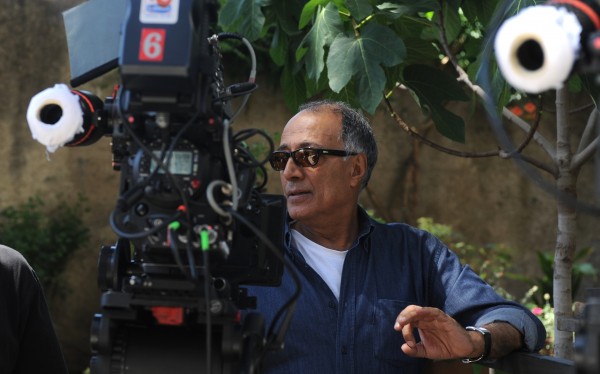
Abbas Kiarostami on the of Like Someone in Love. Image courtesy of IFC Films.
This interview was held at this year’s São Paulo International Film Festival. The Iranian filmmaker Adel Yaraghi, whose first feature Meeting Leila was co-written by Kiarostami, translated Kiarostami’s answers from Farsi to English.
In your absence
I converse with you,
when you are there
I converse with myself.
– Untitled Abbas Kiarostami poem, published in his collection A Wolf Lying in Wait
Like Someone in Love begins in a bar, with the sound of a disembodied voice on a phone. In time, a young woman on a mobile comes into view. She is speaking with her boyfriend, who is interrogating her. As the night goes on, Akiko (Rin Takanashi), a university student longing for sleep, will ignore his demands in favor of propositions from two lonely elders: her grandmother, who is in Tokyo for the night and leaving numerous voicemails, and Takashi (Tadashi Okuno), an old sociologist and translator who has hired her to spend the night with him. Shortly after she enters his home, he shows her a portrait that he considers his ideal woman, and encourages her to stand beneath it.
Both Akiko and Takashi, we sense, have worked to shield themselves from interacting with real people, and the film’s visual design reflects this. For Akiko, whose refuge is sleep, the solution to conflict lies in moving offscreen; for Takashi, who lives in a fragile fortress of memories, the solution is to build frames for himself and live subsequently behind closed doors. Yet the two are far from alone in walling themselves inside their individual realities, as each person they meet—most notably Akiko’s boyfriend Noriaki (Ryô Kase), a car mechanic who demands that her “grandfather” accept him, and Takashi’s old female neighbor (Mihoko Suzuki), who leans out her window dreaming of marriage—has also built his or her own. The film’s Tokyo is an isolated and isolating place; the most extended view that we get of the city is from inside a taxicab, as Akiko looks for someone she knows. In this place, a knock on a car window can seem like a violation.
This conflicted worldview, in which one opens oneself to discovering a place while still feeling troubled by one’s foreignness to it, and even desiring to keep oneself apart from it, belongs unmistakably to the film’s director, the Iranian Abbas Kiarostami. The brave new worlds that trouble his characters often include beloved humans as well as new locations—in fact, the emotional distance between two people often proves harder to cross than any road. Yet though this latest film follows a career-long attempt to traverse that distance, its approach is new. Its method is less like the mobile pursuit of pleading, or erupting, couples in many of Kiarostami’s previous films, including his recent Italy-set feature, Certified Copy (2010), and more like a distilled succession of frozen moments involving solitary people. It is as though the film itself is contemplating a solitude that has already long been realized.
This solitude belongs to the filmmaker’s gaze as much as it does to any character’s. Something often lost in discussions of Kiarostami’s filmmaking, and perhaps forming more appropriate comparisons to Like Someone in Love than his previous films, are his parallel careers as a poet (with two collections published in English) and as a still photographer (many works of which can be glimpsed in the 2005 short film Roads of Kiarostami). In both he strives, as he does here, to record first-person impressions. The poems, usually falling between two and six lines, register quiet instants of appreciation (“A young moon/an old wine/a new friend”); the photographs, often in black and white, feel equally illusory, capturing natural beauties like trees and paths quickly and from a distance. As with Like Someone in Love, the images of both the poems and photographs linger after vanishing, regardless of whether their subjects seem physical or ephemeral. Love, too, is a sight that one catches.
What are the major differences for you between being in love and being like someone in love?
I think being in love is a period into which we fall and out of which we fall. It’s a temporary period, and not one that goes on forever. Having said that, this title would be applied to anybody who is in love, because after we fall out of love we think, “How was it that I fell in love, and how did I spend that period of time?” This happens even with the classic love affairs that we experience in literature, or that we have in real life. To talk about the four main characters of the film—the old gentleman, the girl, the boyfriend, and the old man’s female neighbor—this title would apply to all of them.
How did you come to make a film in Tokyo?
The idea for the film came from a single image that I saw when I was in Tokyo many years ago. We were passing by a neighborhood very late at night, a neighborhood full of businessmen in black suits, with black ties and briefcases, all very businesslike. They were surrounding a young girl who was wearing a wedding gown. The image of the white wedding gown between all these black suits was very interesting to me. When I asked what she was doing in between all these men, I was told that she was one member of a group of young women who would come to Tokyo and, in order to pay their university tuition, would work part-time as escorts for businessmen. This image led me, years later, to make a film about the girl.
To build a character, in any script or book or story, you have to have a character’s background. I imagined this girl as someone who had come from a small town to a big town to live and work and study. So the starting point for the film was her and her situation, and then other characters gathered around her. As is necessary for any story, I had to find a group of people to be with her in order to explain her character more. I had to bring these other characters into the story to help create and show her, to help bring her out from being a cardboard character to a character with perspective and three-dimensionality. It soon came naturally that she would be surrounded by some men, such as her pimp, the old man, and her boyfriend, and so they became part of the story as well.
Naturally, in going from writing the script to actually filming the story, we tried to envision this character of the girl and the surrounding characters as best as we could in all aspects. We cast the actress that I thought would be most right for the character, then I chose a pimp, and I chose her girlfriend, and her boyfriend, and all the people that she was involved with.
You establish a pattern at the beginning of Like Someone in Love in which people are isolated from each other spatially. There are characters who are speaking to each other but who do not appear in the same shot. Why?
This film is radical in that it doesn’t have a specific beginning, nor does it have a specific end. We are never on time for any story. In real-life situations we always get into the story late, and we always leave the story too early. So this was a chance for me to emphasize that in a radical way—to emphasize that this is how it is. We start the film, or any story that would surround us, by hearing first. Even if we take this hotel where we are having our interview as an example, if there is an interesting story going on, if it were to catch our attention it would be through aural means first. And then if we were interested, then we would want to seek the story out with our eyes and watch it. In this film I used the same technique—or the same pattern, as you might say. We get into the story by hearing it first, and then, once we’ve heard enough to be interested, wanting to know what will go on next, then we go to the visual part. So this was a technique that I used to emphasize a reality that exists.
What interested you about the reality that you were filming?
My first sight of Tokyo was a touristic vision. I saw it as a tourist, more so than from looking at it with a Japanese point of view. But what remained with me afterwards, and what was interesting to me, were the traditional Japanese ways of life and culture. I knew them from being in Tokyo my first time, and being there again reiterated my feelings and made me want to see these things once more.
Sometimes I think that my familiarity with Japan came out of my experience of watching Yasujiro Ozu’s films, which were shown in the Tehran cinematheque when I was 20. But when I think again, I feel that it might be that my familiarity with Japanese culture and with the Japanese way of life is even older than that. I think that it might come from the haikus that I read when I was young. They deal very much with images, and explain images in poetic form, and to me they have a lot to do with the Japanese way of looking at life.
I also started photography more than 35 years ago, and if you ever see my photographs, you will see that they are very similar to Japanese homemade black-and-white paintings. So my familiarity with Japan is very old. I don’t know where this familiarity started, but I feel that it comes from way, way back in my life.
You are also a poet. What do you see as the commonalities between your poetry and your cinema?
The main similarity lies in their starting points. They both come out of the same person, and they both come from the same way of looking at life. They both explore things that interest me, like Nature or naturalistic people—introverted people who are natural and real. So I think that the poems are like the films, only, instead of being put together by frames, they are put together by words. The works in both forms are similar to each other, and they influence each other as well.
Tehran, Tuscany, Tokyo: Where is next?
I wish Iran, but if it does not happen, Italy. There are two different projects that I’m working on, so whichever project is more possible, then that place will be next.
Like Someone in Love opens through IFC Films on February 15.
]]>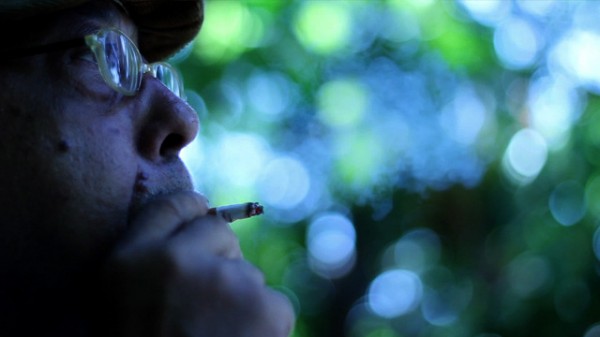
Image courtesy of Eryk Rocha.
The old black man moves slowly. He’s seen a lot, you can tell, and you don’t need words to know it. The years, months, and days are folded into each of his wrinkles, standing out between his remaining gray-white wisps of hair, and weighing down his bent spine. But there’s a lightness in his step, and a casual grace about him that goes equally far beyond words. It’s as if he tells observers with each delicate shuffle that he’s been through so much already, and lasted; whatever else he undertakes, he’s going to be fine.
His name is Jards Anet da Silva, or Jards Macalé, and he was born in 1943 in Rio de Janeiro, where he still lives. He’s the focal point of the new documentary Jards, one of several rich discoveries at this year’s recently concluded edition of the São Paulo International Film Festival. He is also a musician—more precisely, a singer—who’s been recording since 1970. But if you don’t already know of him, then his first recording session in the movie is going to come as a shock.
The sequence starts with a medium close-up of Jards wearing headphones, then moves in even closer to make his round face gigantic within the widescreen frame. The old man, mainly silent up to now, unleashes sound. It seems to stir up from within the bottom of his gut, course through his thin chest and veiny neck, and burst out of the gate of his mouth and teeth in the form of the words “Belo dia!” He calls the day beautiful through force of will.
As he keeps singing, the camera turns shakily around him. Bright light bursts in to cover him, and he moves in and out of focus until clarity is finally reached. The left-hand side of the frame stays empty throughout, as though waiting for someone—perhaps us, perhaps somebody else—to step in. His lips contort to sculpt the shapes of each subsequent word; for Jards, language is raw material for creation as well as for communication. By the end of his song, the sun’s come out, the world’s been formed again, and—if it hasn’t happened already—we’re exhausted, energized, alert, and just a little more awake.
The film Jards, in which our hero records a new album, is about discovering how many different ways exist of hearing and seeing a person, as well as how many different angles exist to watch him from. The director Eryk Rocha (no coincidence—son of Glauber) has worked largely as a portraitist in his previous films, all documentaries save for the recent fiction-doc hybrid Passerby (2010), a black-and-white following of a quiet old man over the course of a day throughout Rio. (Passerby received its American premiere this year at the Museum of Modern Art’s series Premiere Brazil!; Jards has yet to play Stateside.)
Here he presents his human subject through a variety of styles and shooting formats. While in the musical sequences Jards almost invariably appears in high-res color HDCam images, the qualities of the quiet, solitary interludes between them vary greatly. Sometimes Jards, sitting on the veranda of his beach house or walking alone as waves crash impressionistically around him, is seen in color, sometimes in black-and-white. Sometimes he is shot from an outsider’s observational view in full curved figure; at other moments, it’s as if you’re seeing the air vibrate blurrily through his bespectacled eyes. Sometimes, without explanation or transition, the grainy, tattered, film images captured during his youth run onscreen, as a jovial young man parties with friends in an alleyway. These are moments of downtime, allowing space for reflection. Each different style, we sense, reflects a different part of Jards’ head—long-bubbling introspection and brief, immediate joy, distorting darkness, distending radiance. They all come together with force and energy when he sings.
Early on Jards looks up his own song lyrics on Google. Later, his in-process recordings of his greatest hits will receive accompaniment from special guest stars such as Luiz Melodia, Frejat, and Thais Gulin, each of whom fills the once-empty frame space in order to duet with him. The film doesn’t need to generate suspense or even much of a narrative, because it’s a register of a moment. The handheld camera captures procedural details—the way a finger plays a chord or a key, the way a tongue lifts a note—to give an unusually intimate look at how music is made collaboratively, sound by sound.
Throughout, Jards gives the sense of artistic creation bringing a life into focus. This sense carries over from the recording sessions to the listening booth and other studio spaces, where the producers and players lounge and laugh when they’re not debating where to go next. Jards moves among them, seemingly cheerful. He doesn’t need to say what he’s thinking, because his T-shirt, which reads “always traveling in music,” might already.
]]>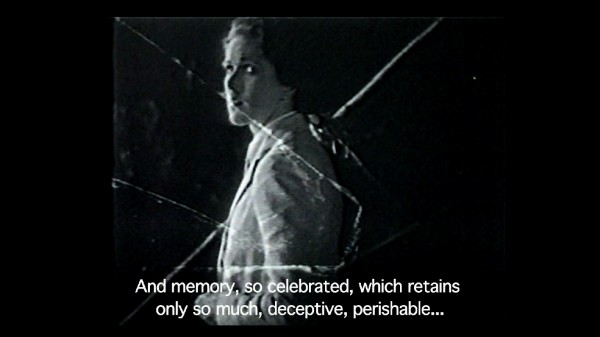
And while we use images to remember what there is,
And we keep the images we’ve created,
Maybe what’s left will come and join us.
How many readers know Fährmann Maria? It’s an early German sound film from 1936 directed by Frank Wisbar, who would later escape the Nazis and spend the rest of his film career in the United States making low-budget noir. The film, recently restored by the organization Arte, unfolds at nighttime on the outskirts of a small rural town, where a church bell accompanies the sounds of wind in the trees. A pale, tall, bald man (Peter Voß), clad in black, has been murdering the local ferrymen, leaving the chief rower’s post open for Maria (Sybille Schmitz), a newly-arrived drifter who announces, “I’m a stranger with no home.” She tells this to a beautiful young man (Aribert Mog) whose life she saved from the evil one, and with whom she subsequently might be falling in love. While he feverishly dreams of horsemen riding to take him, she dons a black dress, prepared to sacrifice herself for his sake, and marches grimly across a watery plain. She meets the monster and takes him to town with her, where a village ball lies underway. The dawn approaches quickly. She holds this new man in her arms, and dances with Death to vanquish him.
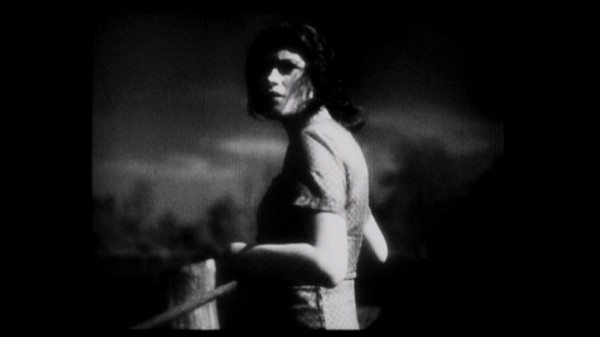
A video image of Maria staring forward into the night, rope in her hands, can be glimpsed within Marcelo Felix’s new, elusively beautiful essay film Eden’s Ark. (I discovered Arkat this year’s edition of Rotterdam; the film has also recently shown at Brussel’s Âge D’Or/Filmvondsten and São Paulo’s Museum of Image and Sound, with future screenings planned in Montreal, Moscow, and Minas Gerais). A story begins about a storm that’s been raging for three weeks and counting, and a group of sailors on an ark escaping it. While images of flowers flash by, the unseen people devote themselves to recording their memory within “an organic book” in which everything is written. “Impossible images drip from every page,” a female voice (Isable Machado) says, “but the book was never finished.” The up-close, clear botanical views of purple leaves contrast with people barely glimpsed, far away, walking through what looks like snow. “Who might these men and women have been, whose image wasn’t kept but in the guts of those who loved them?”
The sea appears in tinted, scratched filmed archive images; the shaky, crinkled, golden green of filmed potential plants arrives along with real leaves. Ark carries, catalogues, and attempts to preserve endangered species—several unfamiliar flowers and other plants, as well as unfamiliar films (glimpsed in clips) like Elmer Clifton’s Down to the Sea in Ships (1922), Sidney Olcott’s Little Old New York (1923), Rino Lupo’s The Unknown (1926), Max de Haas’s Prof. Went in the Botanical Laboratory (1932). Ephemeral fragments from family film collections float throughout all the other presented and perceived films. A multiple consciousness is emerging, we sense, that commingles objects, their images, images of those images, and the viewer’s connections between them. The voice, speaking over the images, says, “We invent memory.”

At first, films were often seen by their creators as merely dispensable objects, and many studios destroyed them as soon as their commercial lives had ended. Often the works were simply neglected, and left to be destroyed by time. Now more than 75 percent of all known silent films alone are lost entirely, and a great number more only survive in damaged fragments found by chance. Even many of the best new restorations of older films, like the World Cinema Foundation and Cinemateca Brasileira’s work on Mário Peixoto’s masterful filmed remembrance of a woman lost at sea, Limite (1931), (glimpsed in Eden’s Ark), contains pieces burned beyond repair.
As older, torn and burned archive images of nature appear in EEden’s Ark, one comes to think of film itself as an endangered species. Images of ticking clocks from whole, known silent films (Boris Barnet’s The Girl with the Hatbox, Harold Lloyd hanging from the clocktower in Safety Last!) underline the rapidity of time passing, then segue into a tale of how the opening minutes of the great filmmaker Josef von Sternberg’s The Case of Lena Smith (1929) were found by a researcher visiting a Chinese flea market. There are few film images more famous than Renée Falconetti’s face framed in close-up within Carl Theodor Dreyer’s film The Passion of Joan of Arc (1928), but as Eden’s Ark recounts, the film might be lost if a copy hadn’t been found in a Norwegian mental hospital. There’s something unnerving about the sensation of watching frames of Falconetti pass through an editing machine’s sprockets. Films are not inanimate objects for anyone who’s ever watched one, yet seeing them for what they ultimately are renders all their powerful memory associations into something fragile and perishable, as fragile and as perishable as any lifeform.
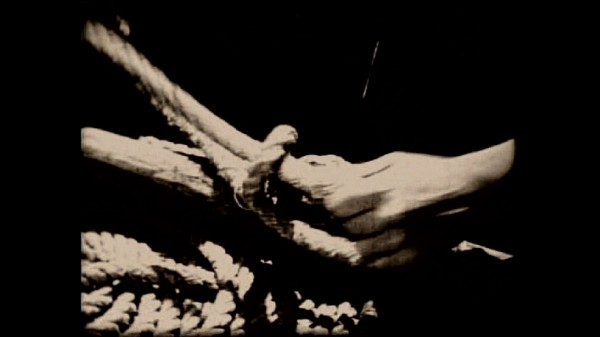
Falconetti never appeared in another movie, and I know of no images of her that exist other than in Dreyer’s film. Early films appeal to the imagination in particular, I think, not only because they are endangered, but also because they preserve humanity in a way many later films don’t. Barnet, Lloyd, Chaplin, Keaton, Gish, and many more silent stars carry worlds in their faces, often staring directly at you. Silent films encourage viewers to address them. As we create relationships with the people we’re watching, we also watch ourselves, remembering some moments from our lives and imagining others in dialogue with the people onscreen.
Marcelo Felix was born in 1967, more than 30 years after the silent era ended. The Portuguese filmmaker, poet, and editor has also studied film restoration and archiving. His debut feature, a digital preservation of older films, contains a new silent film in tribute. Carried throughout Eden’s Ark are pieces of Der Baum der Flüchtete, a 1929 film (approximately) about a scientist (Friedrich Went) and his curious young assistant Velma (Maria Carlota Saldanha) searching for new plant species, their images rendered in brightly tinted celluloid full of computer-added scratches and burns. Vilma holds up her binoculars and says, “I saw a tree like that once before.” She hopes to find it again someday, “Even if it only lives in dreams.”
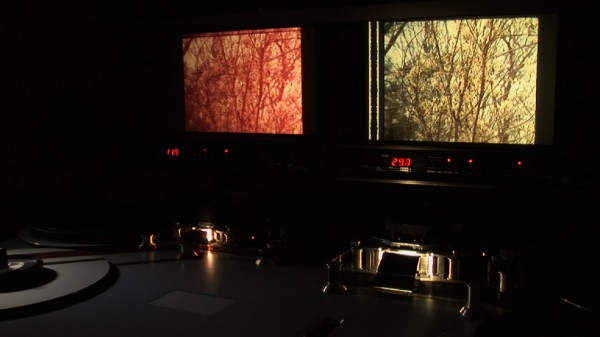
How has your interest in silent film emerged?
Being able to see The Wind, The Passion of Joan of Arc, Greed, The Crowd, on TV… These films were a revelation for me in my late teens. They were my introduction to a fascinating world, where everything seemed strangely sophisticated: the visual narrative, the intertitles with subtle, quasi-aural texts, the peculiar interaction and pace of all these elements. I started looking for every opportunity to watch silent films. Most projections at the Cinemateca, in Lisbon, had no musical accompaniment then — that absence underlined the visuals, and the uniqueness of the experience.
How has your interest in film preservation emerged?
It came naturally with loving cinema, to watch so many films knowing about their missing parts, films dismembered by their own producers, or by censorship, or whatever vicissitudes. One has to make a distinction between films missing, probably for good, and films available, in whatever condition and quantity of materials. But no matter the case, there’s room for some sort of restoration. Most films no longer extant left some trace somewhere, so it’s possible to restore their existence to memory. My interest began with that thought.
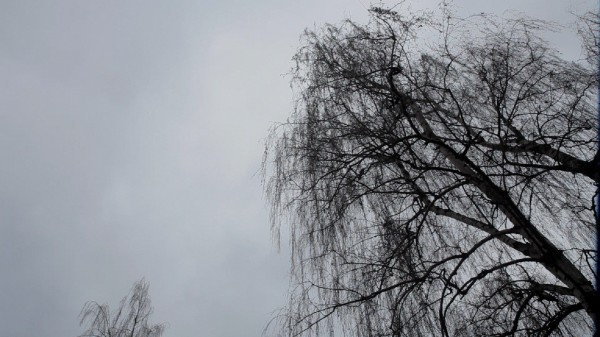
How did you come up with the idea in Eden’s Ark of pairing film preservation with the movement of the seasons?
For me there’s an analogy between natural preservation and film preservation. Eden’s Ark’s point of departure was the inauguration four years ago of the Svalbard Global Seed Vault. I thought about a possible beginning for such a story, an alternative ark that would carry all the known collectible species of plants in the world in order to save them from the deluge. In the beginning, there’s just the accumulation of things. Then the confusion, of how to go through it and to make sense of it. How do you convey this information? How do you transmit it? If these species are on the verge of a catastrophe, what can you do?
You have to know them, so you have to systematize that knowledge, but you also have to give an idea of how things looked. It’s intuitive for us to draw immediately, to make a picture. How do you do that for a plant? Somebody in the ark’s crew should at this point imagine as well that a picture does not transmit everything about the way a thing is, so one way of transmitting a little more is to see how it moves, how it reflects, how it shines. So maybe moving images could be the imagined answer. Maybe during this travel they were proposing and even inventing a pre-cinema. For me it was a very funny challenge to make this convergence an organic thing. You don’t think much about it, but it’s already related — the will to preserve this species is related to that visual knowledge of it. Nature with image, and then how to preserve both. Later on you will have to preserve images of things that do not exist anymore, then you will have to preserve copies of those images, etc. This problem was introduced from the beginning.
You’re in the position of having to recreate things, and even make substitutes for them. This happens a lot with extinct species, as well as with silent films. For example, the new version of Metropolis combines scenes from different prints, and new title cards in the place of scenes that are still missing. What is your attitude about this?
Metropolis was a very helpful experience for me. With the recently restored copy, everybody understands what the missing scenes were and how they fit. For me, if they were missing, but we still knew what was missing (as well as their positions), I could perfectly cope with the absence of those images. I would imagine them by reading the description of the action. I could make myself an alternative film for a while, an alternative image, an alternative sequence.
The fake film in Eden’s Ark is also within this principle. It’s a sort of an action that is encapsulated, and then fragmented. Those are excerpts of some German film from the ‘20s, not perfectly mimicked, but evocative of the process of trying to relive something that is in very bad shape. The image is very degraded, there are parts missing, we have the indication that some text is lost, and that the intertitles are new and replaced the old ones, which were either damaged or missing. It’s familiar to us to watch films that constitute themselves as something didactic, in terms of “We are not hiding that this is in very bad shape and that there are things missing.” I find that nice. I relate to that.
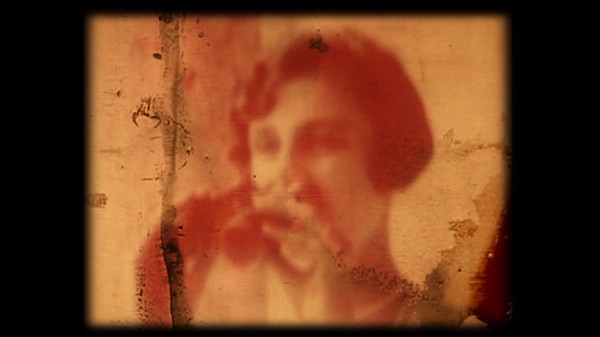
How did you create the dreamt film? Why German, and why 1929?
The film date was symbolic. Many films made on the eve of the talking period were quickly neglected and forgotten. I wanted fragments of a film that, through its subject and decayed images, could help us feel the precariousness of life and memory that Eden’s Ark is about. I felt that such a story would be plausible in an unknown German film. In the end it’s a dreamy mix of a Dutch documentary, a Portuguese feature film and Italian bits and pieces, all battered in post-production.
How did you see the voiceover working in the film, and what did you want from Isabel Machado’s delivery?
There are three voices in the film, but only one voiceover, who narrates, comments, and replies to another, written voice. It was important for me to have the text evolve like a dialogue — sometimes a faux dialogue — between two parts complementing each other’s thoughts. I intended it to stress the film’s structure, of permanent enquiry and doubts. There was no rigid program for Isabel’s voiceover. Hers is a sometimes distanced, sometimes engaged text. I gave her some directions – but she’s my producer, my greatest critic, and an ardent supporter of the film, so she knew what I wanted better than I did.
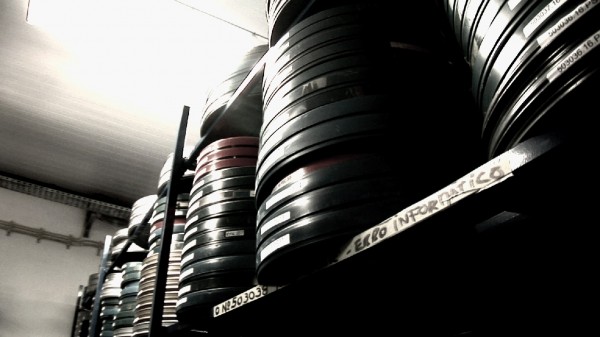
What is the film deposit you show?
It’s the national moving image archive, a beautiful villa at Lisbon’s outskirts, with lots of room, which such institutions usually lack. It has a special bunker for nitrate where we filmed the vaults, and the main building is dedicated to all the processes of film preservation. They have labs, an identification department, and reconstruction rooms — physical repairing and digital restoration. It’s a very well-equipped but undermanned facility.
What are the special challenges of restoring silent films for you, as opposed to later films?
The challenge for me is not technical, because I think that any film that you put your hands on you’ll have people that will come up with the adequate ideas to relive it, to make the best of that particular fragment or feature. It’s more the time that you have while you are working, you’re giving so much with so few human resources, and while working on some films you are postponing others. It’s not that it’s bad the way it is, but we can’t cope with the passing of time. Some things will disappear because you are saving others. You are opting for what a certain context and certain circumstances tell you is important. For sure the films you are saving are important, but this will leave you less time to deal with other things, and it will eventually come to a situation in which it will be too late to try to save them, let alone do something so good as what a Murnau film or a Dreyer film will always deserve. For me, it’s always a matter of time. And then of course divulging these films, these results, and incorporating them into your living search through cinema.
Do you believe every film should be saved?
I believe we do not have the time to save even those films that we know we would love. For me the problem is not that everything should be saved. In the end, we won’t be saved. I think we’ll remain somehow, but while we are here of course we’re missing a lot of things. It’s our condition.
I’m tremendously curious for things that I won’t be able to watch. I wanted to transmit that urge by getting this fragment of The Case of Lena Smith. A Japanese researcher and theoretician, Hiroshi Komatsu, found the beginning of this lost film — it amounted to a reel of about four minutes — in a flea market in China. There’s nothing else from the film but a wonderful collection of stills. The effect that it exerted on me was the curiosity to watch this fragment — in order to have the experience, for sure, but also to measure the absence of all the rest. I wanted to use part of the newly discovered excerpt in counterpoint to the sequences that only remain in the form of still frames. So the idea was: it’s the beginning of the film, and while this is happening — while we have Esther Ralston in a promenade in Vienna — everything is still possible. And then things sort of freeze, and we no longer have that, and this is absence. This is what we have for a lot of things that we could love. To have a glimpse, and understand that this is so precarious. Unfortunately we haven’t been granted permission to use the excerpt… I finally edited the whole sequence over stills reflected on an eye — it’s the eye that moves.

How did you decide to present the images from preexisting films in this new film?
From the start I wanted to include a number of excerpts from favorite films, which could support the narrative, in a sometimes evocative, sometimes dynamic way. I wanted the movement from Soviet films that are a bit like slapstick — I have Boris Barnet, I would have liked to include Abram Room, but in fact this is a very low-budget project, and those are very expensive films, a bit unexpectedly. And Harold Lloyd, which is the American counterpart with Safety Last!, it’s a hugely expensive thing just having those 5-6 seconds.
I also thought in terms of motifs. For instance, the idea of the rope that is a character in itself throughout Eden’s Ark was something that came to me by that image of Fährmann Maria, a really haunting visualization of the heroine’s challenge to the unknown. Her courage, and her fragility, seemed to me to symbolize something that would be best expressed in her fight against death. We had, relatively long before The Seventh Seal, a figuration of death that was similar. The dark-clad figure with sinister looks, but with an agenda. It’s not an irrational character, it’s someone that pursues an objective and can be cheated, and can be eventually killed. Fährmann Maria is a film that kills death in order to preserve love, and a film that kills death — all films for me, in a way, transmit that image. Image kills time.
Do you feel that mortality is the secret subject of every movie?
It’s one of the secret subjects. Every filmmaker is carrying it in a way. It can be clumsy, or desperate. Or it can be very interesting.
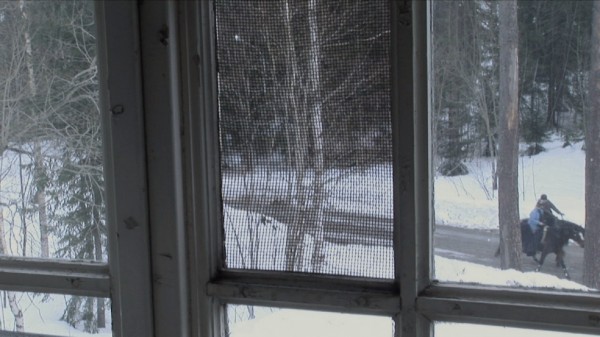
How did you decide to present the outdoors?
I always thought that we would have to shoot in vast spaces. There were several levels of presentation of this idea of nature. One would be the wild, unprotected nature in the Amazon. Then the controlled and exposable and logical image of nature in the botanical gardens. And finally the invisible, ultra-protected nature in the seed vaults. This global seed vault, it is like the limit of utopian preservation, confined in a bunker that is relatively small, with a huge ambition of protecting every culture of food interest, though not every botanical culture. It’s very specialized. It’s a small place in a huge landscape. For me, the vastness would always be something that the film would tend to, because vastness would communicate the unknown, and the undecided, and the absent, and the impossibility of finding answers in that reassuring way that you believe when you are in civilization and pretend that these problems are not problems, that you have time, that there’s a logic in all this, and that to preserve is something natural.
To preserve is natural?
I think the idea of keeping is so innate in us that we could live both with that and with the absence of that: the idea that we should know and that knowing is also having. It’s having the advantage of experience, the possibility of reading the world and having keys to understand it, that otherwise we as individuals and as a species will just lose.

What do you think of new kinds of digital restoration?
I’m really not very worried in terms of the substance of preservation, of the options that you’ll have available, because in the end…Nitrate is an experience. It’s a beautiful experience that can be better or worse reproduced in a digital transfer. But most of the silent films that I’ve seen, I haven’t seen them projected, in nitrate prints. And maybe half of my overall film viewing or a little more I’ve seen on very small screens. I would never have the chance to see all those films projected. I know that these films can be projected, it’s good to have that choice, but I’m more worried as to the possibilities of projecting them when we’re not having film anymore.
And since Eden’s Ark is digital, you’re presenting celluloid images digitally.
Yes, there’s a problem that my film postpones, because my film is integrated into what the technology is now, even if it evokes the fact that it is also a transcription from another format. But the technological leap means that you’ll eventually lose film, and then how do you make new stocks of it in order to transfer the things that are waiting? So digital is not — of course it helps, but it’s not really a disinterested help, it became the only way. From now on you’ll have to research that path. At the same time, you’ll soon end up with no technology and no expertise with all the things that dealt with film, and in the absence of an industry of film, there will be no spare parts for all these editing tables and these projectors.
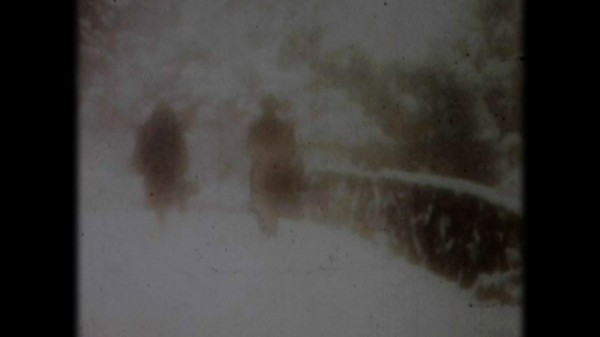
So is this the future for you?
It does not have to be, but economically I think that it will probably evolve into something that won’t go back to film, unless there’s some evolution you can’t imagine, a huge retro-seduction that will make these things practical and unexpectedly visible again.
What did you think of The Artist?
Its happy end is the main character, a movie star, overcoming his decline when he finally makes a comeback, in a talking picture. That’s the completion of his recovery, and I couldn’t help feeling that in such context silent film was made look like a sort of unhealthy condition — The Artist reinforces this reasoning by becoming a talkie itself at that moment. It’s a common approach to the silent era, summing up the drama of its ending to actors with inadequate voices or accents, struggling for their careers. When in fact it was a whole, vibrant form of practicing the art of cinema that ceased then, its evolution interrupted. That was a road not taken, and it can’t certainly be reopened and revived without truly understanding its poetry.

What are the present situation’s positives?
I think there’s more demand for knowledge, since there is more the idea of what we are missing, but at the same time we are not being systematically governed by this will of knowledge. When I read that normally a silent film DVD doesn’t sell more than 800 or 1,000 copies in the United States, the whole country, I believe that we are being governed by other priorities that turn this part of our patrimony into something that is a deluxe, superfluous product. And I think this patrimony can’t survive by itself, it must be supported. That’s also a part of the analogy between the preservations of nature and of images. Both realities are mined with precariousness of budgets, and things can be canceled, can be downgraded, can be abandoned. We can’t take anything for granted. It’s like life. So we have to try and share and take advantage of the things that we can have access to.
Thanks to Dave Kehr for research help, and for loving old movies.
all images courtesy of C.R.I.M. Productions
]]>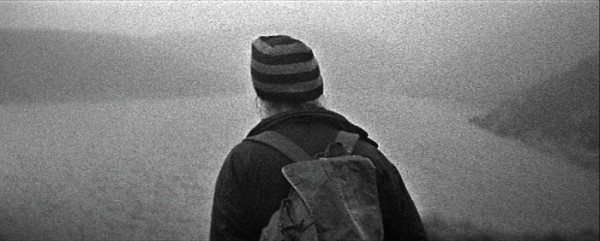
We the People, declared the title of Ben Rivers’ 2004 short film, predicting the subjects of movies to come. Black-and-white views of an empty, narrow street between buildings; mob cries alternating with the noise of one lone pair of shoes. Who are they? Where are they? When is this?
These questions come up in Rivers’s films, which leave you uncertain, but curious and grasping to know more. The people and habitats can fit together sweetly; in A World Rattled of Habit (2008), a Russian émigré and his adult son lounge around their sloppy trailer, listening to music. The jolly, fat elder recalls his family’s problems and his travels from Russia to the States to Germany to England. “So all mission of each individual, my way, you have to see that through, and navigate through the shit it’s you’re floating through,” he says of life.
The joy of Rivers’s movies is often mixed with dread. May Tomorrow Shine the Brightest of All Your Many Days As It Will Be Your Last (2009, co-directed with Paul Harnden) shakily shows cloaked figures moving through woods, followed by soldiers, and seeking quiet places to read, seemingly in escape from some kind of disaster. A metallic ring obscures words spoken offscreen; wind blows through shimmering trees. It’s only occasionally that we see faces beneath their cloaks—a solemn old man, a blankly gazing old woman.
The 39 year-old Rivers originally studied sculpture at the Falmouth School of Art in his native England, then made installations, then moved to 16mm cinema in search of better ways to capture the human form. Lately he’s been watching how people move through landscapes. The old hands work slowly and gracefully, heads down, through the aging factory in Sack Barrow (2011); the children play freely in the trash heap, turning to show off the odd monster masks they’ve made in Ah, Liberty! (2008); Jake Williams tromps through the woods, his boots crunching snow, in Rivers’s first feature, Two Years at Sea (2011).
The slim, balding, long-bearded Williams worked for two years in the Far East as a merchant seaman, saving up enough money to make a place for himself back in England, but far from its madding crowd. Sea is his third film with Rivers and, like the other two (This is My Land [2006] and I Know Where I’m Going [2009]), it’s set around his country home. He walks through the large wooden house and showers in a trailer, his cat keeping him company. He explores the surrounding hills, sometimes silently, sometimes accompanied by Indian records. He eventually heads to the lake, makes himself a boat, and sets out on the water before returning to land. It’s that simple, perhaps.
Yet there’s something disquieting about this Paradise, perhaps the feeling that it could be lost. The large ‘Scope framing full of objects suggests Jake’s a small, temporary piece of this place, which can keep living without him; the continual changing of the seasons affirms it will.
Sea addresses one of Rivers’s lingering concerns, which is the fragility of any man-made paradise—always temporary, maybe, because life is short. The photos of unidentified smiling people that appear periodically, frozen, recall the still images that open the filmmaker’s earlier Slow Action (2010) (showing in New York this Sunday, May 20, as part of this year’s Migrating Forms festival). Slow Action is a catalogue of imaginary Utopias, combining images of depopulated islands with “Memories not of what has been, but of what might be,” as put by one of two narrators speaking sci-fi writer Mark von Schlegell’s stunning voiceover. We learn that, “Everywhere new utopias are possible,” but also that, “Utopia is by definition no place: It can only be approached, never reached.” The questions of whether Jake lives in a utopia, and how long it can last if he does, haunt Two Years, especially since the movie leaves them open.
Ideal worlds are built from elements of the real thing. Rivers’s movies take known worlds and then estrange them, encouraging us to create our own spaces beyond the frame. His people are always moving towards something, though that something is rarely specified. Whether their initial settings are familiarly working-class or exotically tropical, there’s always the feeling that they can go somewhere else, somewhere undiscovered. I think that’s what ultimately accounts for the conflicting sensations the films give of exhilaration and quiet terror. The prospect of pure freedom is unnerving, partly because it means giving up what we know. As Jake sets out on the water in Two Years at Sea, his raft lit by candles, one can recall Slow Action’s “principle of possible abandonment necessary to any utopia… At any time, one may leave the island on a boat.”
I spoke to Rivers at this year’s Rotterdam festival about Sea in particular, a few months before it would screen near my home in São Paulo. A new film, Phantoms of a Libertine, recently premiered at London’s Kate MacGarry gallery, and later this year will come A Spell to Ward Off the Darkness, made in collaboration with the American Ben Russell. Yet each of Rivers’s movies gives the sense of being part of a continuing evolution, and you feel that any time you talk about one, you’re also discussing the rest. This includes all the films we only imagine.
You’ve said you’re a big Paul Sharits fan.
I wouldn’t single him out as the experimental filmmaker that had the biggest impact on me. It’s an accumulative thing. From art school I started running a film club, then I moved to Brighton, and then some friends and I opened a cinema. We were screening three times a week, and we would show a lot of experimental work. Sharits was one of those people that we showed quite a lot, but that was probably more my co-programmer’s choice than mine. I showed a lot of George Kuchar. I’m a huge George Kuchar fan. I’d say, of all the experimentalists, he probably had the biggest impact. For starters, he was the first I saw.
I’d only ever seen feature films before, so I had no idea that there was this enormous other world of cinema. When I was at art school someone gave me a videotape with four Kuchar films on it which the BFI had released, and it just had this profound effect of showing me a whole different set of possibilities. Seeing things like Sharits is like seeing film as even a physical moment, which is something you can get with some action films, but it’s very different because it’s not—it’s purely about that kind of assault. It doesn’t try to pull you in any other way, in any deceptive way with narrative and manipulation. It’s there, and you’re there with it. That was pretty impressive. With George Kuchar I was struck by his beautiful cinematography, amazing editing and sound, the use of found music, all made with extremely independent means. As someone at art school, with no film teaching, it was enough to see that making films was possible if I just got a Super-8 camera, filmed my friends, edited on an 8mm viewer, and then played the films with accompanying soundtracks stolen mainly from old Universal Pictures films. If I hadn’t seen Kuchar I may have made the mistake of going to film school.
Then there were other people that I discovered along the way, like Ron Rice, Margaret Tait, John Smith, Bruce Baillie, Chick Strand, I could go on for ages… but watching experimental films always went alongside watching all other kinds of filmmaking, and this was the ethos of Brighton Cinematheque, that we would show all different forms of cinema; it’s all cinema.
Sharits is very formal and structural, while Kuchar is much more prone to following human beings. With Two Years at Sea, you’re using a person as a formal element.
He’s also very human. He’s someone I’m very attached to, and whom I feel a lot of warmth towards. When you talk about him as a formal element that makes him sound too much like he’s a Bressonian model or something, which I probably wouldn’t go along with.
I mean more like what Brakhage said—“All that is is light.” When you were filming, how conscious were you of him as an actual person with needs and desires, and how conscious were you of him as a visual subject?
I think it’s a simultaneous thing. I try and stay aware of them both. When you’re looking through the viewfinder, then it can become more formal. I have a fairly clear idea when I compose the kind of images that I want, so that does usually mean that it can be like moving a human being to fit your requirements – but it’s looser than the usual blocking out of a scene – I think I will often make a person aware of the parameters of the shot and they can move freely within that. Sometimes this isn’t possible, because the shot parameters are too tight, so it does need blocking. The thing is, I watch his movements and I am following them before I run the camera. Then the ways I move him are basically ways that he would ordinarily move. As a filmmaker, for the sake of the film, you need a certain control; otherwise you’re not going to be satisfied with the film that you are making. I guess it’s trying to find a balance between the human being and the form, and not being too megalomaniacal.
The way that I compose images is pretty instinctive, though that word can be misleading, because it suggests not being aware of what you are doing – but actually I take quite a while to consider shots, it’s just that I only like to do it when I’m looking through the lens. I don’t use storyboards. I don’t pre-plan shots that much. I basically work from lists. It would be “Shower,” “Eating,” “Toilet,” often just single words—a list of single words. Then I’d compose the image with the camera. It’s about finding and feeling what’s right in that moment between Jake, myself, and the camera.
This is the third film you’ve made with Jake. How was the experience different from on the first two?
When I first visited Jake in 2005, on the recommendation of my friend Paul Harnden, who used to live nearby, I had never filmed someone in anything like an observational way before—if people had been in my films they had been directed entirely. Jake was completely welcoming, and after a couple days he seemed very easy with me filming whatever I wanted, some people are just naturals. I shot the first half of the film, not knowing is was the first half until I edited it, then went back in winter to film the second half. Jake enjoyed This Is My Land – so a few years later, when I was driving through blizzards on my way to the Isle of Mull making I Know Where I’m Going, I decided to call in on Jake – and once again he was completely at ease in front of the camera, allowing me film him going about his business. The big difference when I decided to go back again for Two Years At Sea was that I didn’t want him to lead and for the camera to follow, as that would have seemed like repeating what we had done before—so this time I directed, but he retains the same ease in front of the camera, which makes people believe they are watching a straightforward documentary—and this is testament to what a good performer Jake is.
To what extent did you let Jake guide the movie?
I talk about it as collaboration, because we discussed everything. He wouldn’t do anything that he was uncomfortable with doing. There are things in the film that he wouldn’t ordinarily do, with which he was a little bit reluctant, but not so reluctant that he would say no. But there’s also a lot in the film that he governs just by the very nature of being who he is. I can’t think of a better word than “collaboration,” because we sit and have long chats together in the evening. We talk about what the film might be, but this is interspersed between conversations about anything. Stuff going in his life, stuff going on in the world, whatever—just conversation. We don’t even talk about the film that much; it’s like, “OK, I want to do the scene on a lake. How are we gonna do that? Are you OK with doing that?” It’s more like practicalities.
I feel like what’s in the film is mainly, in the end, my decision, and he’s quite happy to go along with all that. It’s not an observational film in that I’m observing him with the camera. It’s observational in that I spend a lot of time observing his life and then I build scenes and shots around what I’ve seen. So it’s more like a reenactment of his life with elements of fiction. This is how I work with all the people in my films – in the end it has nothing to do with making a representational film about the facts of someone’s life, but working with them, using parts of their life and world to make a new one for cinema.
Is that how you think of the film, as being between fiction and documentary?
Yes, because that’s really one of the first things I spoke to him about, which was that I didn’t want to make a documentary. I’m interested in cinema, and I don’t believe in that idea of the objective image. Films are by their nature constructions. Since you choose to point the camera a certain way, you’re in a sense fictionalizing the space. So in making the film the way I did, him reenacting parts of his life also enabled me to move beyond that and into more fictional spaces where he’s playing someone similar to who he is. It’s an exaggeration of certain parts of his life. It leaves out a great deal of the reality of his life. It’s about creating a world that exists just within the film. That’s always my intention, for the film to become a hermetic world.
In a way that’s the theme of the film itself.
Yes, exactly.
Did you always know it would be a sound film?
Yes, I did. But I didn’t always know whether there was going to be dialogue. In the very beginning I thought that there would be other people, so that there would be conversation. And then, after that, I decided that I wanted it to just be Jake, but I still thought that maybe there might be some internal dialogue or monologues or something like that, even him talking to the camera. But I quickly decided that was not the way to move forward. It felt like a nice challenge to set for myself: to make a film with one person, no speech. It did feel like a challenge to try and make that in a way that wasn’t boring, because people like to hear voices. It’s a way of connecting to another human being. But I really like his face, I think he’s got a great face, and he’s very charismatic, he’s very photogenic, and that’s half the battle, in a way. I felt like he could carry the film in his face.
I’m glad you didn’t ask him to shave.
Oh God, I think he’s probably had a beard since the ‘70s.
Aside from the articulated words in the songs, do you feel that there is language in the film? If so, what, and what kinds?
He does say a couple of things. There’s also a language of gestures, and the language of images. I would say that his movements and gestures are a language of sorts. There’s also a language of the objects you see in the film, of space and of the way that space is constructed, the things that he has accumulated. You could look at them as a kind of language we’ve built up to picture the person he is. The things that one surrounds oneself with. The language of cinema.
Even though there aren’t other people in the movie, I do see him interacting with other characters—the lake, the objects in his house, the boat he goes out on.
His cat is a pretty crucial bit of company; that cat’s been there for a long time. It’s really about his relationship with that landscape and with those things around him. You don’t necessarily need other people to have different characters. Which was why I decided in the end just to have him. I thought it was enough just to have him interacting with all this other stuff around him. As much as he likes other people, the overriding desire above being around other people was being in that place. That was the strongest draw. So it seemed like the most important thing to try and get over was that relationship.
How did you find the film’s structure?
Months of fiddling. Editing takes me a while. Playing around with sound is quite often why, adding sounds to images to give them life and take them in different directions. I knew I wanted photographs to figure in the film, and for quite a while they occurred all at the same moment, with Jake looking through them. That was how it was edited for a while. And then I realized that I could use them as a kind of chapter headings. Because the way that it was coming together felt episodic. The lake scene. The caravan scene. It just made sense to have them as episodes with these chapter breaks. The beginning and the end were pretty clear in my mind early on, with him walking through the snow, returning home, and the fire fading to blackness.
Do you think Jake lives in a Utopia?
One of the reasons I’m interested in Utopia is that what it means to one person can be the opposite of what it means to another—this is partly what Slow Action is all about. Jake’s place in Two Years at Sea is close to a kind of utopia, as it’s the dream he had of living, achieved. The thing is, it is imperfect, and it is in these imperfections and contradictions that my interests lie—I am not really excited by the idea of finding the perfect place, and the word utopia points to this: it is no place, unattainable, but we can try at least to get near it. Jake’s world is very close to what he had wanted, but there is also underlying unease—this could be related to loneliness, or to the broken and discarded memories of society strewn around, or to the felled trees that he sees when he goes for walks that look like part of the devastated landscape they are in, or the weather, perhaps. So there is a great deal of joy and freedom to be had, but there are complications in that, and I like that.
You processed the film in your kitchen sink. Why?
It was partly tied into the decision to film in black and white – I was having difficulty deciding whether to film in color or not, and in the end thought that black and white would help move the film away from an idea of documentary if paired with the ‘Scope ratio. I also decided to use black and white because it would help mask some discontinuity, of which I thought there might be a lot, because I knew I would be filming on and off over the course of a year. The final push was that Kodak announced they would stop producing plus-x film, so I bought as much as I could find and filled my fridge.
This leads back to the hand-processing, which feels appropriate to my filmmaking and particularly to this film. I’ve made a series of films about people who live off in the wilderness, and they live very physical lives, and you’re there with the dirt and the muck and the elements and all that stuff, and it’s not in any way sanitized. I think that to mirror that with the physical nature of film—having my hands on it, processing it, not handing it over to a kind of mechanized or industrialized way of working—was important. It’s hands-on, do-it-yourself. It makes sense as a continuation of what I’m interested in, in Jake’s life and in some of the other people’s lives. It feels natural.
For Amos Vogel, with thanks to Andréa Picard for research help.
]]>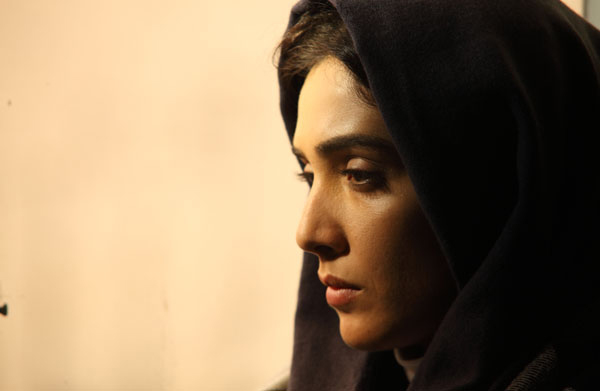
still from "Goodbye," 2011. courtesy of Film Center Lincoln Center.
Goodbye, showing Thursday, March 22 and Saturday, March 24 as part of this year’s New Directors/New Films festival, is a film of reflections, mirrors, and sideward glances. The law student, Noora (Leyla Zareh), trapped inside her apartment, gives water to her turtle, roaming inside its glass case. She stares at the photo on her wall of a smiling child, which stares at her pregnant belly.
She is considering an abortion, and she’s also considering leaving Iran. We don’t know why she’s considering either, exactly, and don’t find out until late in the film. But she can’t get the abortion without her husband’s permission, and her husband is far from Tehran, in the South. Meanwhile, her deadline approaches.
In Mohammad Rasoulof’s latest film, we watch a world where nothing can be hidden, only obscured a little. It’s a world where men control women’s destinies, and can either abandon or invade their lives at any time. Its stark, flat images might seem familiar if you know Goodbye’s backstory: Rasoulof was making a film with friend and fellow director Jafar Panahi in March 2010 when they and 17 others were arrested and charged with creating propaganda against the state. Both he and Panahi were sentenced to six years in prison and banned from filmmaking. While Panahi’s appeal has since been denied (which, as anyone who’s seen This Is Not a Film knows, hasn’t stopped him), Rasoulof’s prison sentence was reduced from six to one year, and then suspended. He has since been released and given permission to work and to travel, and he is still speaking out.
He has consistently spoken out through his five films, which mix personal stories with larger social metaphors. Whether documentary (2008’s Head Wind) or mythology (2009’s The White Meadows), the films become stories of individuals emerging from within oppressed groups. He also speaks out in person, as he did at this year’s edition of Rotterdam. Thanks to Assiyeh Tabatabai for translating Rasoulof’s answers from Farsi to English, and to Aran Jawidiani for providing copies of his films.
What interests you about mirrors?
Are you asking that because I use mirrors in a few shots in the movie?
Yes. For example, the first time Noora receives visitors, you think that the characters are talking in the hallway, but then you realize that it’s actually a reflection of them.
This was really, to be honest, a technique. In the very closed and small spaces where I was shooting, I wanted to use the minimum number of cuts in shooting, so that I could show both sides in the same shot.
How did you find Noora’s apartment?
That’s the apartment of a friend of mine. I had seen it a couple of times, and I had basically designed the story based on that place. What was interesting for me was that when we were shooting within the apartment, I wanted to make clear, when a character enters, the number of steps it takes him or her to get inside. I wanted that to reflect how small and claustrophobic the space was. There was a wall somewhere there in the middle of the apartment that we had to knock down. We had to do a couple of things to bring it to our ideal set, but it had been on my mind from a long time before.
You knocked down a wall, but you also have times where parts of the room hide her from the viewer’s sight. Why?
The content and the subject of my movies are very important for me, but what I also like to do very much is to experience different art forms. I wanted to experience two things in this movie. One was to make the film with the minimum possible number of cuts, so as to make the shot as long as possible without cutting to the next scene. The other thing was to not necessarily bring everything in front of the camera. I wanted to use sound, shadows, light, and a lot of other aspects, rather than having the subject constantly in view.
I think any art form is very much influenced by the conditions the artist is in. I think the result, this movie that I’ve made, comes a lot from the conditions I was experiencing at the time. When I got out of prison, I thought a lot about how my experience would influence my next movie, and how I could use the opportunity to affect my next project. My next work of art.
I didn’t want the movie to be about me. I didn’t want to be the central character at all. And what happens is that there are two groups in Iran about which we hardly talk. It’s very difficult to talk about them. It’s very difficult to do anything worthwhile, certainly any worthwhile movie about them, and even I couldn’t reflect them properly. These are the journalists in Iran and the human rights activists. I have many of these journalists and human rights activists around me and among my friends. I can say that I have made this movie based on a lot of individuals’ lives, and of course our problems are very similar. So putting together these bits and pieces, I get the whole story.
It’s many peoples’ stories, told through one person.
Yes, that’s correct.
The film is also about an individual in a particular situation. What are the actual abortion laws that the film deals with?
Up to week 16 of pregnancy, it’s possible that if the child has problems, any kind of disability, you can get an abortion with a doctor’s supervision. But after week 16, due to Islamic law (Sharia), it’s not possible to get an abortion, even if the child has disabilities. It’s also not possible at any time for a woman to get an abortion without her husband’s permission. In a country where a woman needs her husband’s permission to get a hotel room, this is very natural and obvious.
What do you think of the absence of the woman’s husband?
In the conditions that I live in — in my environment, in my country — reform is often the result of small individual efforts. Individual efforts and personal efforts. Most of it is not coming from organized group effort. Therefore a lot of individuals go out of their way completely to try to make a difference, and it obviously affects their private lives a lot. So what I’m trying to say is that this journalist, the husband, is trying so hard to make a difference that he doesn’t even realize that his wife needs him. He doesn’t even realize that he’s abandoning a pregnant wife. But I really didn’t want to discuss any of the details of the guy’s life in the movie, and I didn’t want to explain his conditions at all. I only tried to make the audience realize at the end of the movie that he’s in prison. But the struggle he goes through, and all that? I didn’t want to touch it at all.
When I was writing the story, I didn’t really pay attention to classical drama’s fundamental issues. I wrote it as is if we are looking at a part of the life of this character, and me as the moviemaker, I had to follow this part of her life. I couldn’t manipulate the story as it was going.
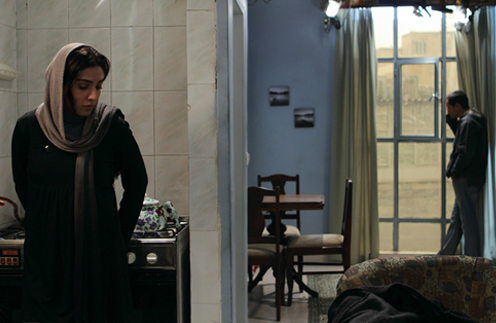
still from "Goodbye," 2011. courtesy of International Film Festival Rotterdam.
You’ve said that this is the character’s fall, her final step. What do you mean? And why is it important to show this?
If we assume that the life of the main character is like a boxing match, what I want to make clear for my audience is that the beginning of my movie is the final punch, and then you have this fall, with events around it in slow motion. She falls in slow motion until she finally hits the ground. I could not make the movie about her fight. I could not picture the whole fight. I could only picture the final fall. My conditions, my situation, the life that I was living at the time would not allow me to portray the whole struggle. So I decided that, instead of portraying the whole fight, I would start the story with the final stroke, and portray all the details, from the hit to the final fall. But when she gets the hit, and throughout the movie until that final fall, you can realize what kind of a battle she’s gone through before we’ve arrived.
What is that final hit? She knows, she realizes at the very beginning of the movie that her child may have Down’s Syndrome. And that is the final stroke.
How did you decide to give the child Down’s Syndrome? And why do you delay telling the audience until so late in the film?
I think these are two very distinct questions, and I will answer them one by one. The first part of the question: Why Down’s Syndrome?
First of all I want to explain something, and that is that I chose the mother-child relationship because I wanted to show that non-physical violence is very present in Iran, even in the most intimate relationships. As you can see in this movie, the mother is willing to sacrifice the life of her child, by which I mean to give birth to a child with a disability, just because it can help her get residency outside Iran. I wanted to depict how harsh the situation is — everybody is being violent toward everybody else, non-physically. Even a mother against her child.
So why Down’s Syndrome? Because I think it’s a metaphor for the situation in my country right now. The relationship that I have with my country is like a familial relationship, and I feel like the whole country is retarded. It’s going a little bit slow and backwards, if you will, which is a result of the violence and aggression of the leaders. This is not only destroying the country, but also individual lives.
And why did I choose to reveal it when I did?
The style I chose was to be as one with the main character. And the character is trying to hide this as much as possible — she doesn’t want anyone to know, because she feels they will judge her. “You’re giving birth to a disabled child just because it will help you get what you want.” So there was no other place or moment in time where she could reveal this. It could have been possible if I brought it from the very beginning of the movie, or if she had talked to someone about it, but neither of these things happened. So the only place where we can find out about this reality is when the doctor tells her through second examinations.
Goodbye reminded me at times of the Palestinian filmmaker Elia Suleiman’s work. What do you think of Suleiman?
I like him very much. Divine Intervention is a very nice movie. The most important thing that really attracts my attention in that movie is that he never takes politicians seriously, and I like the way he belittles them. He has a comical look at politics in general, which I like. Emir Kusturica has it, too.
I’d really love to make a comedy someday, but I’m still stuck with the serious side of life. But I hope to get rid of this acute seriousness one day.
]]>
